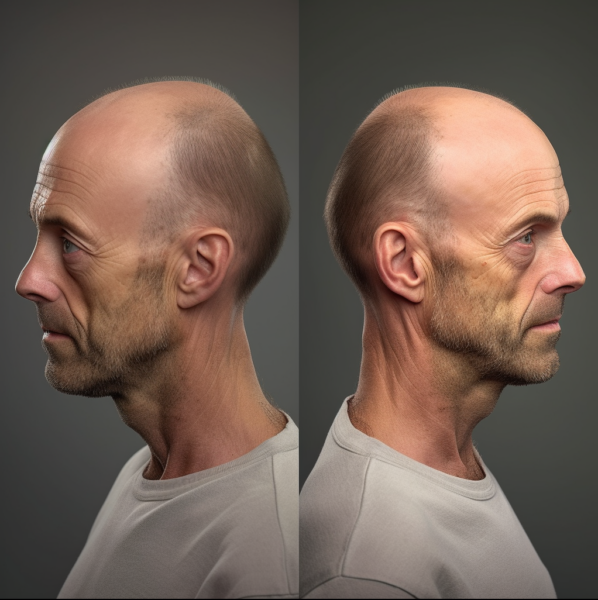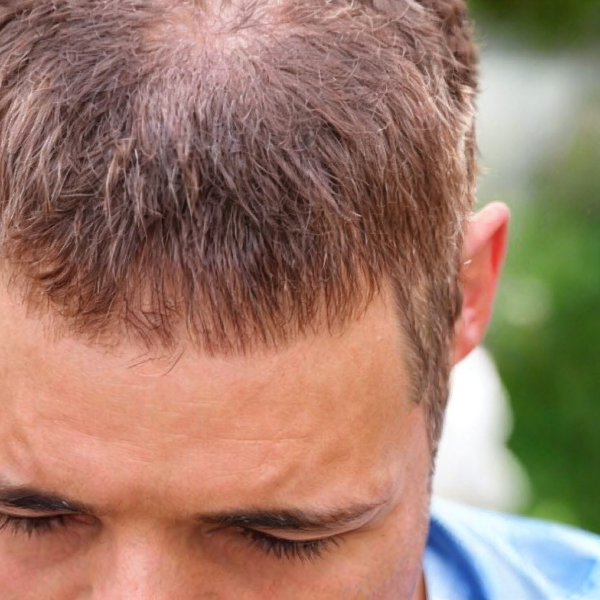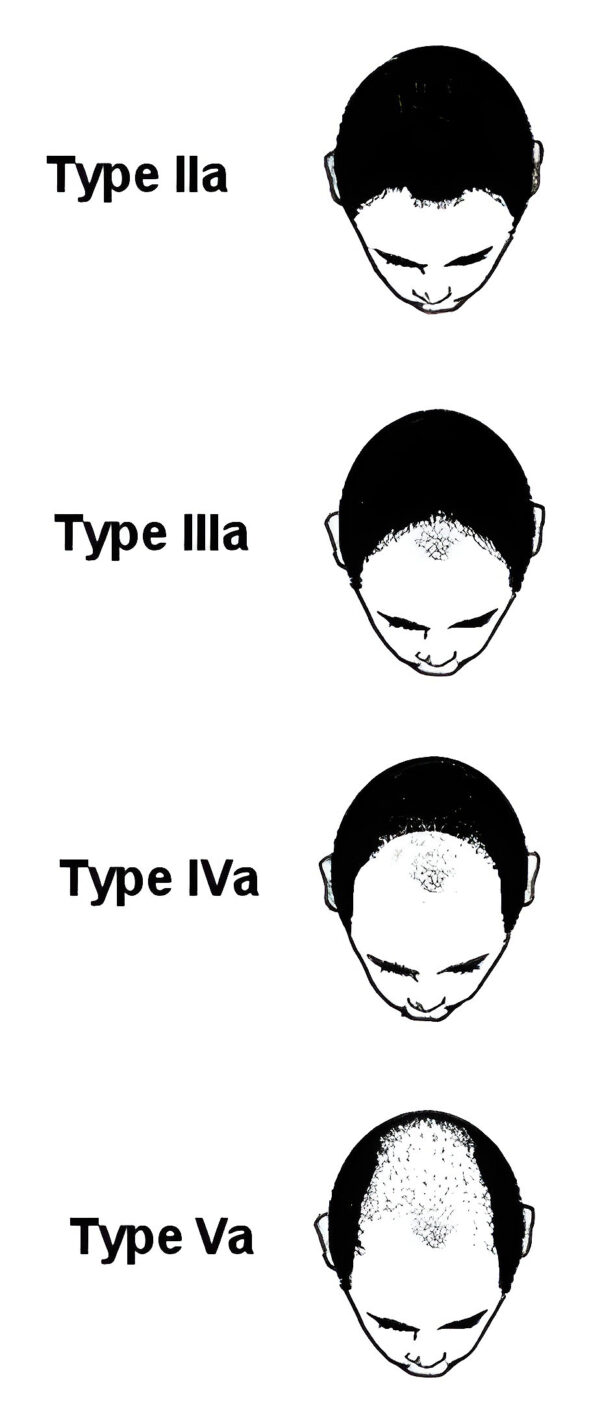Senolytic drugs, a term coined to describe a class of drugs capable of selectively inducing cell death in senescent (sick and aged) cells, have emerged as a promising avenue in the realm of aging research and the treatment of age-related diseases. Senescent cells are characterized by an irreversible cessation of cell division, often exhibiting a pro-inflammatory phenotype. These cells accumulate with age and have been associated with several age-related pathological conditions. It is thought that targeted elimination of senescent cells effectively leaves healthy cells remaining to repopulate tissues and organs, making for a healthier body. Recent studies suggest a potential role for senolytic drugs in addressing hair loss, a common age-associated concern, thereby hinting at a new horizon in hair regrowth therapy.
Senolytic drugs aim to alleviate the negative impacts associated with aging and cellular senescence by promoting the death of senescent cells, thereby potentially extending the healthy lifespan of individuals. The mechanism of action of senolytic drugs predominantly revolves around the disruption of cell survival pathways upon which senescent cells are particularly dependent. This includes targeting proteins such as BCL-2 and p53, or signaling pathways like the PI3K/AKT pathway. By inhibiting these survival pathways, senolytic drugs induce apoptosis in senescent cells, but spare the neighboring healthy, non-senescent cells.
Among the various senolytic agents, Dasatinib, Quercetin, and Navitoclax (ABT-263) are some of the more notable examples. Dasatinib, originally an anti-cancer drug, and Quercetin, a plant flavonoid, have often been used separately and in combination to exert senolytic effects. Navitoclax, on the other hand, targets the BCL-2 family of proteins, which are crucial for the survival of senescent cells. While these are some of the more well-known senolytic drugs under investigation, there are many more senolytic drugs under development with better potency and potentially fewer side effects.
The therapeutic potential of senolytic drugs spans a wide array of age-related diseases. Preliminary studies suggest their beneficial role in conditions like osteoarthritis, atherosclerosis, Alzheimer’s disease, and other neurodegenerative disorders. However, while there is quite a lot of research published on senolytic drugs and their potential use for other conditions and diseases, there has been very little work on the role of senolytic drugs and their impact on hair growth. Indeed, the possible use of senolytic drugs for improving hair growth (and perhaps hair pigmentation as well) seems to have been rather overlooked by the research and medical community.
A 2017 study published in the journal “Cell” highlighted that a peptide capable of blocking the interaction between two proteins (p53 and FOXO4) that are involved in cellular senescence, showed a remarkable improvement in hair growth in aged mice. As part of a larger study looking at progeroid (prematurely aged) mice, this peptide, exhibiting senolytic activity, demonstrated a rejuvenating effect on hair follicles (as well as other tissues), suggesting a potential therapeutic avenue for age-related hair loss.
Furthermore, a 2016 study in “Nature Communications” explored the effects of a senolytic drug combination of Dasatinib and Quercetin in aged mice. This combination showcased an alleviation in the conditions of hair loss and greying, alongside other rejuvenating effects on skin tissues. The findings suggest that targeting senescent cells using senolytic drugs can have broad implications, including the improvement of skin and hair health.
A small study from 2013 looked at the effect of Quercetin on pigmentation of hair follicles from mice and found that the treatment seemed to increase melanogenesis. Another study from Korea suggested that Quercetin stimulated hair shaft growth in cultured human hair follicles along with upregulation of various genes involved with hair fiber production. Most recently, a study from China indicated that Quercetin treatment stimulated the differentiation trajectory in hair follicles and induced angiogenesis probably by activating the expression of HIF-1α in endothelial cells.
Given the results from the studies above, it is a little surprising that there has not been further, larger studies on senolytic drugs and their effects on hair growth. Pattern hair loss in both men and women involves androgen hormone action on dermal papilla cells in susceptible hair follicles. While the exact mechanisms by which androgens cause hair loss are unclear, there is research to suggest that pattern hair loss (androgenetic alopecia) involves premature senescence of dermal papilla cells. In addition, hair thinning is quite common in elderly men and women over the age of 70. Though this form of alopecia has not actually been researched in any detail, the hair thinning is presumed to be a result of general aging. Whether senolytic drugs would be useful in treating these hair loss conditions is unknown, but the few preliminary studies that have been done are encouraging.
However, while the preliminary data is promising, transitioning findings from mouse models and in vitro cell and tissue cultures to human therapy always presents challenges. The specificity of senolytic drugs, potential off-target effects, and the long-term impacts of senolytic therapy are some of the concerns that need thorough investigation. Moreover, a robust mechanism for monitoring the effects of senolytic drugs on hair health in a minimally invasive manner is really needed to advance the research in this field.
The lack of comprehensive clinical trials is another bottleneck. While the preclinical data is promising, rigorous clinical testing is required to ascertain the efficacy and safety of senolytic drugs in humans. This is imperative for understanding the long-term effects of senolytic therapy and establishing the optimal dosing regimens. Furthermore, the development of resistance to senolytic drugs is a plausible concern, somewhat similar to the development of resistance to chemotherapy in cancer treatment. Understanding the molecular mechanisms underlying resistance to senolytics and devising strategies to overcome such resistance is crucial for the long-term success of senolytic therapy.
In conclusion, senolytic drugs, with their ability to target the cellular roots of aging, offer a promising avenue for addressing age-related hair loss and potentially promoting hair regrowth. The initial findings from preclinical studies are indeed exciting and propel the field a step closer to potentially revolutionary treatments for hair loss. However, meticulous research, addressing the challenges, and comprehensive clinical trials are imperative to ascertain the true potential of senolytic drugs in hair health management. As the journey from bench to bedside continues, senolytic drugs remain a compelling subject of research in the quest for effective solutions to age-related hair loss.
Bibliography
11711645 {11711645:NB7RIHWX},{11711645:ETDWSMSC},{11711645:T84FMWJ5},{11711645:UUCHQBIW},{11711645:5RRRKTWK},{11711645:AWJZUWED},{11711645:BBB6DKBW},{11711645:PMZBHZVB},{11711645:A4N7TCHP},{11711645:6N6CW3PJ},{11711645:QSJZU2IK},{11711645:NGUK6Q33},{11711645:UBABJNTW},{11711645:9UCM9RVU},{11711645:QE45BA47},{11711645:25GA6IQX},{11711645:E3Z53FE4} 1 vancouver 50 default asc 570 https://www.keratin.com/wp-content/plugins/zotpress/ %7B%22status%22%3A%22success%22%2C%22updateneeded%22%3Afalse%2C%22instance%22%3Afalse%2C%22meta%22%3A%7B%22request_last%22%3A0%2C%22request_next%22%3A0%2C%22used_cache%22%3Atrue%7D%2C%22data%22%3A%5B%7B%22key%22%3A%22ETDWSMSC%22%2C%22library%22%3A%7B%22id%22%3A11711645%7D%2C%22meta%22%3A%7B%22creatorSummary%22%3A%22Bahta%20et%20al.%22%2C%22parsedDate%22%3A%222008-05%22%2C%22numChildren%22%3A0%7D%2C%22bib%22%3A%22%3Cdiv%20class%3D%5C%22csl-bib-body%5C%22%20style%3D%5C%22line-height%3A%201.35%3B%20%5C%22%3E%5Cn%20%20%3Cdiv%20class%3D%5C%22csl-entry%5C%22%20style%3D%5C%22clear%3A%20left%3B%20%5C%22%3E%5Cn%20%20%20%20%3Cdiv%20class%3D%5C%22csl-left-margin%5C%22%20style%3D%5C%22float%3A%20left%3B%20padding-right%3A%200.5em%3B%20text-align%3A%20right%3B%20width%3A%201em%3B%5C%22%3E1.%3C%5C%2Fdiv%3E%3Cdiv%20class%3D%5C%22csl-right-inline%5C%22%20style%3D%5C%22margin%3A%200%20.4em%200%201.5em%3B%5C%22%3EBahta%20AW%2C%20Farjo%20N%2C%20Farjo%20B%2C%20Philpott%20MP.%20Premature%20senescence%20of%20balding%20dermal%20papilla%20cells%20in%20vitro%20is%20associated%20with%20p16%28INK4a%29%20expression.%20J%20Invest%20Dermatol.%202008%20May%3B128%285%29%3A1088%26%23x2013%3B94.%3C%5C%2Fdiv%3E%5Cn%20%20%20%3C%5C%2Fdiv%3E%5Cn%3C%5C%2Fdiv%3E%22%2C%22data%22%3A%7B%22itemType%22%3A%22journalArticle%22%2C%22title%22%3A%22Premature%20senescence%20of%20balding%20dermal%20papilla%20cells%20in%20vitro%20is%20associated%20with%20p16%28INK4a%29%20expression%22%2C%22creators%22%3A%5B%7B%22creatorType%22%3A%22author%22%2C%22firstName%22%3A%22Adiam%20W.%22%2C%22lastName%22%3A%22Bahta%22%7D%2C%7B%22creatorType%22%3A%22author%22%2C%22firstName%22%3A%22Nilofer%22%2C%22lastName%22%3A%22Farjo%22%7D%2C%7B%22creatorType%22%3A%22author%22%2C%22firstName%22%3A%22Bessam%22%2C%22lastName%22%3A%22Farjo%22%7D%2C%7B%22creatorType%22%3A%22author%22%2C%22firstName%22%3A%22Mike%20P.%22%2C%22lastName%22%3A%22Philpott%22%7D%5D%2C%22abstractNote%22%3A%22Androgenetic%20alopecia%20%28AGA%29%2C%20a%20hereditary%20disorder%20that%20involves%20the%20progressive%20thinning%20of%20hair%20in%20a%20defined%20pattern%2C%20is%20driven%20by%20androgens.%20The%20hair%20follicle%20dermal%20papilla%20%28DP%29%20expresses%20androgen%20receptors%20%28AR%29%20and%20plays%20an%20important%20role%20in%20the%20control%20of%20normal%20hair%20growth.%20In%20AGA%2C%20it%20has%20been%20proposed%20that%20the%20inhibitory%20actions%20of%20androgens%20are%20mediated%20via%20the%20DP%20although%20the%20molecular%20nature%20of%20these%20interactions%20is%20poorly%20understood.%20To%20investigate%20mechanisms%20of%20AGA%2C%20we%20cultured%20DP%20cells%20%28DPC%29%20from%20balding%20and%20non-balding%20scalp%20and%20confirmed%20previous%20reports%20that%20balding%20DPC%20grow%20slower%20in%20vitro%20than%20non-balding%20DPC.%20Loss%20of%20proliferative%20capacity%20of%20balding%20DPC%20was%20associated%20with%20changes%20in%20cell%20morphology%2C%20expression%20of%20senescence-associated%20beta-galactosidase%2C%20as%20well%20as%20decreased%20expression%20of%20proliferating%20cell%20nuclear%20antigen%20and%20Bmi-1%3B%20upregulation%20of%20p16%28INK4a%29%5C%2FpRb%20and%20nuclear%20expression%20of%20markers%20of%20oxidative%20stress%20and%20DNA%20damage%20including%20heat%20shock%20protein-27%2C%20super%20oxide%20dismutase%20catalase%2C%20ataxia-telangiectasia-mutated%20kinase%20%28ATM%29%2C%20and%20ATM-%20and%20Rad3-related%20protein.%20Premature%20senescence%20of%20balding%20DPC%20in%20vitro%20in%20association%20with%20expression%20of%20p16%28INK4a%29%5C%2FpRB%20suggests%20that%20balding%20DPC%20are%20sensitive%20to%20environmental%20stress%20and%20identifies%20alternative%20pathways%20that%20could%20lead%20to%20novel%20therapeutic%20strategies%20for%20treatment%20of%20AGA.%22%2C%22date%22%3A%222008-05%22%2C%22language%22%3A%22eng%22%2C%22DOI%22%3A%2210.1038%5C%2Fsj.jid.5701147%22%2C%22ISSN%22%3A%221523-1747%22%2C%22url%22%3A%22%22%2C%22collections%22%3A%5B%22XM379FGN%22%5D%2C%22dateModified%22%3A%222023-10-27T16%3A30%3A28Z%22%7D%7D%2C%7B%22key%22%3A%22AWJZUWED%22%2C%22library%22%3A%7B%22id%22%3A11711645%7D%2C%22meta%22%3A%7B%22creatorSummary%22%3A%22Huang%20et%20al.%22%2C%22parsedDate%22%3A%222017-05%22%2C%22numChildren%22%3A0%7D%2C%22bib%22%3A%22%3Cdiv%20class%3D%5C%22csl-bib-body%5C%22%20style%3D%5C%22line-height%3A%201.35%3B%20%5C%22%3E%5Cn%20%20%3Cdiv%20class%3D%5C%22csl-entry%5C%22%20style%3D%5C%22clear%3A%20left%3B%20%5C%22%3E%5Cn%20%20%20%20%3Cdiv%20class%3D%5C%22csl-left-margin%5C%22%20style%3D%5C%22float%3A%20left%3B%20padding-right%3A%200.5em%3B%20text-align%3A%20right%3B%20width%3A%201em%3B%5C%22%3E1.%3C%5C%2Fdiv%3E%3Cdiv%20class%3D%5C%22csl-right-inline%5C%22%20style%3D%5C%22margin%3A%200%20.4em%200%201.5em%3B%5C%22%3EHuang%20WY%2C%20Huang%20YC%2C%20Huang%20KS%2C%20Chan%20CC%2C%20Chiu%20HY%2C%20Tsai%20RY%2C%20et%20al.%20Stress-induced%20premature%20senescence%20of%20dermal%20papilla%20cells%20compromises%20hair%20follicle%20epithelial-mesenchymal%20interaction.%20J%20Dermatol%20Sci.%202017%20May%3B86%282%29%3A114%26%23x2013%3B22.%3C%5C%2Fdiv%3E%5Cn%20%20%20%3C%5C%2Fdiv%3E%5Cn%3C%5C%2Fdiv%3E%22%2C%22data%22%3A%7B%22itemType%22%3A%22journalArticle%22%2C%22title%22%3A%22Stress-induced%20premature%20senescence%20of%20dermal%20papilla%20cells%20compromises%20hair%20follicle%20epithelial-mesenchymal%20interaction%22%2C%22creators%22%3A%5B%7B%22creatorType%22%3A%22author%22%2C%22firstName%22%3A%22Wen-Yen%22%2C%22lastName%22%3A%22Huang%22%7D%2C%7B%22creatorType%22%3A%22author%22%2C%22firstName%22%3A%22Yi-Ching%22%2C%22lastName%22%3A%22Huang%22%7D%2C%7B%22creatorType%22%3A%22author%22%2C%22firstName%22%3A%22Kai-Shin%22%2C%22lastName%22%3A%22Huang%22%7D%2C%7B%22creatorType%22%3A%22author%22%2C%22firstName%22%3A%22Chih-Chieh%22%2C%22lastName%22%3A%22Chan%22%7D%2C%7B%22creatorType%22%3A%22author%22%2C%22firstName%22%3A%22Hsien-Yi%22%2C%22lastName%22%3A%22Chiu%22%7D%2C%7B%22creatorType%22%3A%22author%22%2C%22firstName%22%3A%22Ren-Yeu%22%2C%22lastName%22%3A%22Tsai%22%7D%2C%7B%22creatorType%22%3A%22author%22%2C%22firstName%22%3A%22Jung-Yi%22%2C%22lastName%22%3A%22Chan%22%7D%2C%7B%22creatorType%22%3A%22author%22%2C%22firstName%22%3A%22Sung-Jan%22%2C%22lastName%22%3A%22Lin%22%7D%5D%2C%22abstractNote%22%3A%22BACKGROUND%3A%20Hair%20follicle%20is%20miniorgan%20constituted%20by%20keratinocytes%20and%20its%20distinctive%20mesenchyme%20of%20dermal%20papilla.%20Its%20aging%20is%20characterized%20by%20organ%20atrophy%20and%20impaired%20stem%20cell%20activation%20and%20differentiation.%20The%20contribution%20of%20dermal%20papilla%20to%20hair%20follicle%20aging%20change%20is%20not%20well%20understood.%5CnOBJECTIVE%3A%20This%20work%20was%20aimed%20at%20exploring%20the%20possible%20role%20of%20premature%20dermal%20papilla%20senescence%20in%20the%20pathogenesis%20of%20hair%20follicle%20aging.%5CnMETHODS%3A%20Dermal%20papilla%20cells%20were%20challenged%20with%20H2O2%20to%20induce%20premature%20senescence%20and%20the%20proliferation%2C%20apoptosis%2C%20gene%20expression%20and%20protein%20secretion%20were%20characterized.%20Its%20effect%20on%20epithelial-mesenchymal%20interaction%20was%20analyzed%20by%20co-culture%20in%20vitro%20and%20implantation%20of%20protein-coated%20beads%20in%20vivo.%5CnRESULT%3A%20Dermal%20papilla%20cells%20were%20more%20resistant%20to%20oxidative%20stress-induced%20apoptosis%20than%20dermal%20fibroblasts.%20The%20surviving%20dermal%20papilla%20cells%20showed%20signs%20of%20senescence%20but%20still%20preserved%20key%20dermal%20papilla%20signature%20gene%20expression.%20In%20addition%20to%20the%20failure%20to%20respond%20to%20mitogenic%20stimulation%20from%20keratinocytes%2C%20they%20lost%20the%20ability%20to%20induce%20hair%20follicle%20neogenesis%2C%20promoted%20interfollicular%20epidermal%20differentiation%2C%20inhibited%20follicular%20differentiation%20and%2C%20importantly%2C%20suppressed%20clonal%20growth%20of%20hair%20follicle%20stem%20cells.%20They%20produced%20higher%20levels%20of%20multiple%20inflammatory%20cytokines%2C%20including%20IL-6.%20Functionally%2C%20IL-6%20inhibited%20clonal%20keratinocyte%20growth%20in%20vitro%20and%20blocked%20the%20transition%20from%20telogen%20to%20anagen%20in%20vivo.%5CnCONCLUSION%3A%20Stress-induced%20premature%20dermal%20papilla%20senescence%20can%20contribute%20to%20hair%20follicle%20aging%20change%20due%20to%20compromised%20epithelial-mesenchymal%20interaction.%22%2C%22date%22%3A%222017-05%22%2C%22language%22%3A%22eng%22%2C%22DOI%22%3A%2210.1016%5C%2Fj.jdermsci.2017.01.003%22%2C%22ISSN%22%3A%221873-569X%22%2C%22url%22%3A%22%22%2C%22collections%22%3A%5B%22XM379FGN%22%5D%2C%22dateModified%22%3A%222023-10-27T16%3A28%3A53Z%22%7D%7D%2C%7B%22key%22%3A%229UCM9RVU%22%2C%22library%22%3A%7B%22id%22%3A11711645%7D%2C%22meta%22%3A%7B%22creatorSummary%22%3A%22Williams%20et%20al.%22%2C%22parsedDate%22%3A%222020-07%22%2C%22numChildren%22%3A0%7D%2C%22bib%22%3A%22%3Cdiv%20class%3D%5C%22csl-bib-body%5C%22%20style%3D%5C%22line-height%3A%201.35%3B%20%5C%22%3E%5Cn%20%20%3Cdiv%20class%3D%5C%22csl-entry%5C%22%20style%3D%5C%22clear%3A%20left%3B%20%5C%22%3E%5Cn%20%20%20%20%3Cdiv%20class%3D%5C%22csl-left-margin%5C%22%20style%3D%5C%22float%3A%20left%3B%20padding-right%3A%200.5em%3B%20text-align%3A%20right%3B%20width%3A%201em%3B%5C%22%3E1.%3C%5C%2Fdiv%3E%3Cdiv%20class%3D%5C%22csl-right-inline%5C%22%20style%3D%5C%22margin%3A%200%20.4em%200%201.5em%3B%5C%22%3EWilliams%20R%2C%20Pawlus%20AD%2C%20Thornton%20MJ.%20Getting%20under%20the%20skin%20of%20hair%20aging%3A%20the%20impact%20of%20the%20hair%20follicle%20environment.%20Exp%20Dermatol.%202020%20Jul%3B29%287%29%3A588%26%23x2013%3B97.%3C%5C%2Fdiv%3E%5Cn%20%20%20%3C%5C%2Fdiv%3E%5Cn%3C%5C%2Fdiv%3E%22%2C%22data%22%3A%7B%22itemType%22%3A%22journalArticle%22%2C%22title%22%3A%22Getting%20under%20the%20skin%20of%20hair%20aging%3A%20the%20impact%20of%20the%20hair%20follicle%20environment%22%2C%22creators%22%3A%5B%7B%22creatorType%22%3A%22author%22%2C%22firstName%22%3A%22Rachael%22%2C%22lastName%22%3A%22Williams%22%7D%2C%7B%22creatorType%22%3A%22author%22%2C%22firstName%22%3A%22Alison%20D.%22%2C%22lastName%22%3A%22Pawlus%22%7D%2C%7B%22creatorType%22%3A%22author%22%2C%22firstName%22%3A%22M.%20Julie%22%2C%22lastName%22%3A%22Thornton%22%7D%5D%2C%22abstractNote%22%3A%22Like%20the%20skin%2C%20our%20hair%20shows%20striking%20changes%20with%20age%2C%20producing%20hairs%20with%20altered%20diameter%2C%20lustre%20and%20texture.%20The%20biology%20of%20hair%20aging%20has%20focused%20predominately%20on%20various%20aspects%20of%20the%20hair%20cycle%2C%20follicle%20size%20and%20the%20fibre%20produced%2C%20but%20surprisingly%20the%20impact%20of%20the%20aging%20scalp%20dermal%20environment%20on%20the%20hair%20follicle%20and%20fibre%20has%20been%20generally%20overlooked.%20Hair%20loss%20affects%20both%20sexes%20with%20incidence%20increasing%20with%20age.%20In%20men%2C%20male%20pattern-balding%20%28androgenetic%20alopecia%29%20is%20driven%20by%20androgens%20and%20follows%20a%20specific%20pattern%20of%20frontotemporal%20and%20vertex%20regression.%20Women%20also%20experience%20female%20pattern%20hair%20loss%20%28FPHL%29%2C%20presenting%20as%20more%20general%2C%20diffuse%20hair%20thinning.%20Hair%20thinning%20in%20women%20is%20commonly%20associated%20with%20the%20menopause%2C%20corresponding%20with%20other%20age-related%20changes%20in%20skin.%20The%20rapidly%20growing%20hair%20follicle%20undergoes%20continued%20renewal%20throughout%20the%20life%20span%20of%20an%20individual%2C%20where%20it%20is%20exposed%20to%20a%20substantial%20number%20of%20extrinsic%20and%20intrinsic%20stressors.%20As%20the%20hair%20follicle%20sits%20deep%20within%20the%20dermis%20with%20its%20bulb%20residing%20in%20the%20hypodermis%2C%20detrimental%20age-related%20changes%20in%20the%20surrounding%20scalp%20skin%20may%20likely%20disrupt%20the%20hair%20follicle%20machinery.%20The%20impacts%20of%20these%20changes%20are%20unknown%2C%20but%20evidence%20suggests%20that%20scalp%20skin%20aging%20and%20hair%20follicle%20aging%20go%20hand-in-hand.%20Herein%2C%20we%20summarize%20the%20evidence%20that%20the%20age-related%20changes%20observed%20in%20sun-exposed%20human%20skin%20also%20occur%20in%20scalp%20skin%20and%20that%20these%20changes%20are%20likely%20to%20play%20a%20contributing%20role%20in%20the%20aging%20hair%20phenotype.%22%2C%22date%22%3A%222020-07%22%2C%22language%22%3A%22eng%22%2C%22DOI%22%3A%2210.1111%5C%2Fexd.14109%22%2C%22ISSN%22%3A%221600-0625%22%2C%22url%22%3A%22%22%2C%22collections%22%3A%5B%22XM379FGN%22%5D%2C%22dateModified%22%3A%222023-10-27T16%3A27%3A53Z%22%7D%7D%2C%7B%22key%22%3A%22T84FMWJ5%22%2C%22library%22%3A%7B%22id%22%3A11711645%7D%2C%22meta%22%3A%7B%22creatorSummary%22%3A%22Deng%20et%20al.%22%2C%22parsedDate%22%3A%222022-08%22%2C%22numChildren%22%3A0%7D%2C%22bib%22%3A%22%3Cdiv%20class%3D%5C%22csl-bib-body%5C%22%20style%3D%5C%22line-height%3A%201.35%3B%20%5C%22%3E%5Cn%20%20%3Cdiv%20class%3D%5C%22csl-entry%5C%22%20style%3D%5C%22clear%3A%20left%3B%20%5C%22%3E%5Cn%20%20%20%20%3Cdiv%20class%3D%5C%22csl-left-margin%5C%22%20style%3D%5C%22float%3A%20left%3B%20padding-right%3A%200.5em%3B%20text-align%3A%20right%3B%20width%3A%201em%3B%5C%22%3E1.%3C%5C%2Fdiv%3E%3Cdiv%20class%3D%5C%22csl-right-inline%5C%22%20style%3D%5C%22margin%3A%200%20.4em%200%201.5em%3B%5C%22%3EDeng%20Z%2C%20Chen%20M%2C%20Liu%20F%2C%20Wang%20Y%2C%20Xu%20S%2C%20Sha%20K%2C%20et%20al.%20Androgen%20Receptor-Mediated%20Paracrine%20Signaling%20Induces%20Regression%20of%20Blood%20Vessels%20in%20the%20Dermal%20Papilla%20in%20Androgenetic%20Alopecia.%20J%20Invest%20Dermatol.%202022%20Aug%3B142%288%29%3A2088-2099.e9.%3C%5C%2Fdiv%3E%5Cn%20%20%20%3C%5C%2Fdiv%3E%5Cn%3C%5C%2Fdiv%3E%22%2C%22data%22%3A%7B%22itemType%22%3A%22journalArticle%22%2C%22title%22%3A%22Androgen%20Receptor-Mediated%20Paracrine%20Signaling%20Induces%20Regression%20of%20Blood%20Vessels%20in%20the%20Dermal%20Papilla%20in%20Androgenetic%20Alopecia%22%2C%22creators%22%3A%5B%7B%22creatorType%22%3A%22author%22%2C%22firstName%22%3A%22Zhili%22%2C%22lastName%22%3A%22Deng%22%7D%2C%7B%22creatorType%22%3A%22author%22%2C%22firstName%22%3A%22Mengting%22%2C%22lastName%22%3A%22Chen%22%7D%2C%7B%22creatorType%22%3A%22author%22%2C%22firstName%22%3A%22Fangfen%22%2C%22lastName%22%3A%22Liu%22%7D%2C%7B%22creatorType%22%3A%22author%22%2C%22firstName%22%3A%22Yunying%22%2C%22lastName%22%3A%22Wang%22%7D%2C%7B%22creatorType%22%3A%22author%22%2C%22firstName%22%3A%22San%22%2C%22lastName%22%3A%22Xu%22%7D%2C%7B%22creatorType%22%3A%22author%22%2C%22firstName%22%3A%22Ke%22%2C%22lastName%22%3A%22Sha%22%7D%2C%7B%22creatorType%22%3A%22author%22%2C%22firstName%22%3A%22Qinqin%22%2C%22lastName%22%3A%22Peng%22%7D%2C%7B%22creatorType%22%3A%22author%22%2C%22firstName%22%3A%22Zheng%22%2C%22lastName%22%3A%22Wu%22%7D%2C%7B%22creatorType%22%3A%22author%22%2C%22firstName%22%3A%22Wenqin%22%2C%22lastName%22%3A%22Xiao%22%7D%2C%7B%22creatorType%22%3A%22author%22%2C%22firstName%22%3A%22Tangxiele%22%2C%22lastName%22%3A%22Liu%22%7D%2C%7B%22creatorType%22%3A%22author%22%2C%22firstName%22%3A%22Hongfu%22%2C%22lastName%22%3A%22Xie%22%7D%2C%7B%22creatorType%22%3A%22author%22%2C%22firstName%22%3A%22Ji%22%2C%22lastName%22%3A%22Li%22%7D%5D%2C%22abstractNote%22%3A%22Androgenetic%20alopecia%20%28AGA%29%2C%20also%20known%20as%20male%20pattern%20baldness%2C%20is%20associated%20with%20androgen%20and%20androgen%20receptor%20%28AR%29%20signaling%3B%20however%2C%20the%20pathogenesis%20of%20AGA%20remains%20largely%20unknown.%20In%20this%20study%2C%20we%20show%20that%20nuclear%20localization%20of%20AR%20is%20elevated%20in%20the%20dermal%20papilla%20%28DP%29%20of%20balding%20scalp%20in%20patients%20with%20AGA.%20Transcriptome%20analysis%20identifies%20microvascular%20abnormalities%20in%20the%20DP%20of%20balding%20scalp%20compared%20with%20nonbalding%20scalp%20of%20patients%20with%20AGA.%20We%20provide%20further%20evidence%20that%20blood%20vessels%20regress%20in%20the%20DP%20of%20balding%20scalp%20at%20the%20early%20stage%20of%20hair%20follicle%20miniaturization%20in%20AGA%20development.%20Consistently%2C%20we%20find%20that%20microvascular%20vessels%20accumulate%20around%20the%20DP%20on%20anagen%20initiation%2C%20and%20angiogenesis%20is%20required%20for%20hair%20regeneration%20in%20mice.%20Mechanistically%2C%20we%20show%20that%20AR-mediated%20paracrine%20signaling%2C%20mainly%20TGF%5Cu03b2%20signaling%2C%20from%20DP%20cells%20induces%20apoptosis%20of%20microvascular%20endothelial%20cells%20in%20the%20DP%20of%20balding%20scalp%20of%20AGA.%20These%20findings%20define%20a%20role%20of%20AR-mediated%20regression%20of%20blood%20vessels%20in%20DP%20in%20AGA%20and%20support%20the%20notion%20that%20early%20anti-AR%20treatment%20is%20better%20than%20late%20treatment.%22%2C%22date%22%3A%222022-08%22%2C%22language%22%3A%22eng%22%2C%22DOI%22%3A%2210.1016%5C%2Fj.jid.2022.01.003%22%2C%22ISSN%22%3A%221523-1747%22%2C%22url%22%3A%22%22%2C%22collections%22%3A%5B%22XM379FGN%22%5D%2C%22dateModified%22%3A%222023-10-27T16%3A27%3A12Z%22%7D%7D%2C%7B%22key%22%3A%225RRRKTWK%22%2C%22library%22%3A%7B%22id%22%3A11711645%7D%2C%22meta%22%3A%7B%22creatorSummary%22%3A%22Han%20et%20al.%22%2C%22parsedDate%22%3A%222022%22%2C%22numChildren%22%3A0%7D%2C%22bib%22%3A%22%3Cdiv%20class%3D%5C%22csl-bib-body%5C%22%20style%3D%5C%22line-height%3A%201.35%3B%20%5C%22%3E%5Cn%20%20%3Cdiv%20class%3D%5C%22csl-entry%5C%22%20style%3D%5C%22clear%3A%20left%3B%20%5C%22%3E%5Cn%20%20%20%20%3Cdiv%20class%3D%5C%22csl-left-margin%5C%22%20style%3D%5C%22float%3A%20left%3B%20padding-right%3A%200.5em%3B%20text-align%3A%20right%3B%20width%3A%201em%3B%5C%22%3E1.%3C%5C%2Fdiv%3E%3Cdiv%20class%3D%5C%22csl-right-inline%5C%22%20style%3D%5C%22margin%3A%200%20.4em%200%201.5em%3B%5C%22%3EHan%20J%2C%20Lin%20K%2C%20Choo%20H%2C%20He%20J%2C%20Wang%20X%2C%20Wu%20Y%2C%20et%20al.%20%26%23x3B2%3B-Catenin%20Signaling%20Evokes%20Hair%20Follicle%20Senescence%20by%20Accelerating%20the%20Differentiation%20of%20Hair%20Follicle%20Mesenchymal%20Progenitors.%20Front%20Cell%20Dev%20Biol.%202022%3B10%3A839519.%3C%5C%2Fdiv%3E%5Cn%20%20%20%3C%5C%2Fdiv%3E%5Cn%3C%5C%2Fdiv%3E%22%2C%22data%22%3A%7B%22itemType%22%3A%22journalArticle%22%2C%22title%22%3A%22%5Cu03b2-Catenin%20Signaling%20Evokes%20Hair%20Follicle%20Senescence%20by%20Accelerating%20the%20Differentiation%20of%20Hair%20Follicle%20Mesenchymal%20Progenitors%22%2C%22creators%22%3A%5B%7B%22creatorType%22%3A%22author%22%2C%22firstName%22%3A%22Jimin%22%2C%22lastName%22%3A%22Han%22%7D%2C%7B%22creatorType%22%3A%22author%22%2C%22firstName%22%3A%22Kaijun%22%2C%22lastName%22%3A%22Lin%22%7D%2C%7B%22creatorType%22%3A%22author%22%2C%22firstName%22%3A%22Huiqin%22%2C%22lastName%22%3A%22Choo%22%7D%2C%7B%22creatorType%22%3A%22author%22%2C%22firstName%22%3A%22Jia%22%2C%22lastName%22%3A%22He%22%7D%2C%7B%22creatorType%22%3A%22author%22%2C%22firstName%22%3A%22Xusheng%22%2C%22lastName%22%3A%22Wang%22%7D%2C%7B%22creatorType%22%3A%22author%22%2C%22firstName%22%3A%22Yaojiong%22%2C%22lastName%22%3A%22Wu%22%7D%2C%7B%22creatorType%22%3A%22author%22%2C%22firstName%22%3A%22Xiaodong%22%2C%22lastName%22%3A%22Chen%22%7D%5D%2C%22abstractNote%22%3A%22Rationale%3A%20%5Cu03b2-catenin%20signaling%20controls%20multiple%20fibroblast%20subsets%2C%20with%20its%20overactivity%20promoting%20the%20differentiation%20of%20hair%20follicle%20dermal%20stem%20cells%20%28hfDSCs%29%20and%20the%20hyperactivation%20of%20interfollicular%20fibroblasts.%20Understanding%20the%20concept%20of%20hfDSC%20activation%20and%20modulation%20offers%20hope%20towards%20the%20therapeutic%20armamentarium%20in%20dermatology%20and%20related%20comorbidities%2C%20as%20well%20as%20their%20potential%20applications%20in%20gerontology%20%28the%20study%20of%20physiological%20aging%29.%20Having%20a%20comprehensive%20understanding%20in%20this%20stochastic%20process%20could%20also%20further%20yield%20important%2C%20novel%20insights%20into%20the%20molecular%20basis%20of%20skin%20aging%20to%20improve%20lifespan%20and%20preventing%20aging-related%20diseases.%20Methods%3A%20A%20new%20CD34CrePGR%20mouse%20line%20was%20generated.%20Through%20fate-tracing%20models%20and%20a%20series%20of%20%5Cu03b2-catenin%20genetic%20experiments%2C%20our%20study%20depicts%20how%20the%20wound%20environment%20increases%20phosphorylated%20%5Cu03b2-catenin%20in%20hfDSCs%20and%20facilitates%20their%20differentiation%20into%20dermal%20papilla%20%28DP%29%20and%20dermal%20sheath%20%28DS%29.%20In%20mice%20carrying%20hfDSC-specific%20activated%20allele%20of%20%5Cu03b2-catenin%2C%20hfDSCs%20accelerated%20their%20differentiation%20into%20DP%20cells.%20Results%3A%20Notably%2C%20with%20%5Cu03b2-catenin%20stabilization%20in%20CD34-expressing%20cells%20and%20potential%20activation%20of%20canonical%20Wnt%20signaling%2C%20the%20mutant%20mice%20showed%20a%20brief%20increase%20of%20hair%20density%20in%20the%20short%20term%2C%20but%20over%20time%20leads%20to%20a%20senescence%20phenotype%20developing%20premature%20canities%20and%20thinning%20%5Bhair%20follicle%20%28HF%29%20miniaturization%5D.%20Conclusion%3A%20%5Cu03b2-catenin%20signaling%20drove%20HF%20senescence%20by%20accelerating%20differentiation%20of%20CD34%2B%20hfDSCs%2C%20resulting%20in%20phenotypes%20attributable%20to%20the%20differentiation%20of%20the%20hfDSCs%20into%20DP%20cells%20and%20the%20loss%20of%20their%20stem%20cell%20potential.%20Therefore%2C%20our%20study%20reveals%20that%20the%20regulation%20of%20%5Cu03b2-catenin%20signaling%20in%20hfDSCs%20may%20potentially%20become%20an%20important%20subject%20for%20future%20exploration%20in%20development%20of%20clinically%20effective%20therapies%20for%20hair%20loss%20treatment%20and%20an%20excellent%20model%20for%20revealing%20new%20therapeutic%20approaches%20to%20reverse%20aging%20or%20retarding%20the%20development%20of%20alopecia.%22%2C%22date%22%3A%222022%22%2C%22language%22%3A%22eng%22%2C%22DOI%22%3A%2210.3389%5C%2Ffcell.2022.839519%22%2C%22ISSN%22%3A%222296-634X%22%2C%22url%22%3A%22%22%2C%22collections%22%3A%5B%22XM379FGN%22%5D%2C%22dateModified%22%3A%222023-10-27T16%3A26%3A56Z%22%7D%7D%2C%7B%22key%22%3A%22UUCHQBIW%22%2C%22library%22%3A%7B%22id%22%3A11711645%7D%2C%22meta%22%3A%7B%22creatorSummary%22%3A%22Deng%20et%20al.%22%2C%22parsedDate%22%3A%222023%22%2C%22numChildren%22%3A0%7D%2C%22bib%22%3A%22%3Cdiv%20class%3D%5C%22csl-bib-body%5C%22%20style%3D%5C%22line-height%3A%201.35%3B%20%5C%22%3E%5Cn%20%20%3Cdiv%20class%3D%5C%22csl-entry%5C%22%20style%3D%5C%22clear%3A%20left%3B%20%5C%22%3E%5Cn%20%20%20%20%3Cdiv%20class%3D%5C%22csl-left-margin%5C%22%20style%3D%5C%22float%3A%20left%3B%20padding-right%3A%200.5em%3B%20text-align%3A%20right%3B%20width%3A%201em%3B%5C%22%3E1.%3C%5C%2Fdiv%3E%3Cdiv%20class%3D%5C%22csl-right-inline%5C%22%20style%3D%5C%22margin%3A%200%20.4em%200%201.5em%3B%5C%22%3EDeng%20Y%2C%20Wang%20M%2C%20He%20Y%2C%20Liu%20F%2C%20Chen%20L%2C%20Xiong%20X.%20Cellular%20Senescence%3A%20Ageing%20and%20Androgenetic%20Alopecia.%20Dermatology.%202023%3B239%284%29%3A533%26%23x2013%3B41.%3C%5C%2Fdiv%3E%5Cn%20%20%20%3C%5C%2Fdiv%3E%5Cn%3C%5C%2Fdiv%3E%22%2C%22data%22%3A%7B%22itemType%22%3A%22journalArticle%22%2C%22title%22%3A%22Cellular%20Senescence%3A%20Ageing%20and%20Androgenetic%20Alopecia%22%2C%22creators%22%3A%5B%7B%22creatorType%22%3A%22author%22%2C%22firstName%22%3A%22Yongqiong%22%2C%22lastName%22%3A%22Deng%22%7D%2C%7B%22creatorType%22%3A%22author%22%2C%22firstName%22%3A%22Mengxue%22%2C%22lastName%22%3A%22Wang%22%7D%2C%7B%22creatorType%22%3A%22author%22%2C%22firstName%22%3A%22Yuxin%22%2C%22lastName%22%3A%22He%22%7D%2C%7B%22creatorType%22%3A%22author%22%2C%22firstName%22%3A%22Fuming%22%2C%22lastName%22%3A%22Liu%22%7D%2C%7B%22creatorType%22%3A%22author%22%2C%22firstName%22%3A%22Lingna%22%2C%22lastName%22%3A%22Chen%22%7D%2C%7B%22creatorType%22%3A%22author%22%2C%22firstName%22%3A%22Xia%22%2C%22lastName%22%3A%22Xiong%22%7D%5D%2C%22abstractNote%22%3A%22Androgenetic%20alopecia%20%28AGA%29%20is%20the%20most%20common%20type%20of%20hair%20loss%20and%20features%20progressive%20miniaturization%20of%20hair%20follicles.%20Generally%2C%20the%20occurrence%20of%20AGA%20has%20long%20been%20thought%20to%20be%20driven%20by%20genetic%20and%20androgen%20predisposition.%20However%2C%20increasingly%2C%20data%20proposed%20ageing%20and%20AGA%20are%20intimately%20linked.%20Elevated%20senescent%20cell%20burden%20and%20androgen%20and%20oxidative%20stress-induced%20senescence%20mechanisms%20in%20ageing%20may%20be%20initial%20targets%20to%20improve%20AGA.%20This%20review%20summarizes%20the%20biological%20links%20between%20ageing%20and%20AGA%2C%20with%20special%20focus%20on%20cellular%20senescence.%20In%20addition%2C%20we%20discuss%20the%20potential%20therapeutic%20strategies%20for%20improving%20cellular%20senescence%20in%20AGA%2C%20such%20as%20inhibiting%20dermal%20papilla%20cells%20and%20hair%20follicle%20stem%20cells%20senescence%20driven%20by%20androgen%20and%20reactive%20oxygen%20species%2C%20removing%20senescent%20cell%2C%20and%20reducing%20senescence-associated%20secretory%20phenotype%20%28SASP%29.%22%2C%22date%22%3A%222023%22%2C%22language%22%3A%22eng%22%2C%22DOI%22%3A%2210.1159%5C%2F000530681%22%2C%22ISSN%22%3A%221421-9832%22%2C%22url%22%3A%22%22%2C%22collections%22%3A%5B%22XM379FGN%22%5D%2C%22dateModified%22%3A%222023-10-27T16%3A26%3A11Z%22%7D%7D%2C%7B%22key%22%3A%22BBB6DKBW%22%2C%22library%22%3A%7B%22id%22%3A11711645%7D%2C%22meta%22%3A%7B%22creatorSummary%22%3A%22Kim%20et%20al.%22%2C%22parsedDate%22%3A%222020-09-02%22%2C%22numChildren%22%3A0%7D%2C%22bib%22%3A%22%3Cdiv%20class%3D%5C%22csl-bib-body%5C%22%20style%3D%5C%22line-height%3A%201.35%3B%20%5C%22%3E%5Cn%20%20%3Cdiv%20class%3D%5C%22csl-entry%5C%22%20style%3D%5C%22clear%3A%20left%3B%20%5C%22%3E%5Cn%20%20%20%20%3Cdiv%20class%3D%5C%22csl-left-margin%5C%22%20style%3D%5C%22float%3A%20left%3B%20padding-right%3A%200.5em%3B%20text-align%3A%20right%3B%20width%3A%201em%3B%5C%22%3E1.%3C%5C%2Fdiv%3E%3Cdiv%20class%3D%5C%22csl-right-inline%5C%22%20style%3D%5C%22margin%3A%200%20.4em%200%201.5em%3B%5C%22%3EKim%20J%2C%20Kim%20SR%2C%20Choi%20YH%2C%20Shin%20JY%2C%20Kim%20CD%2C%20Kang%20NG%2C%20et%20al.%20Quercitrin%20Stimulates%20Hair%20Growth%20with%20Enhanced%20Expression%20of%20Growth%20Factors%20via%20Activation%20of%20MAPK%5C%2FCREB%20Signaling%20Pathway.%20Molecules.%202020%20Sep%202%3B25%2817%29%3A4004.%3C%5C%2Fdiv%3E%5Cn%20%20%20%3C%5C%2Fdiv%3E%5Cn%3C%5C%2Fdiv%3E%22%2C%22data%22%3A%7B%22itemType%22%3A%22journalArticle%22%2C%22title%22%3A%22Quercitrin%20Stimulates%20Hair%20Growth%20with%20Enhanced%20Expression%20of%20Growth%20Factors%20via%20Activation%20of%20MAPK%5C%2FCREB%20Signaling%20Pathway%22%2C%22creators%22%3A%5B%7B%22creatorType%22%3A%22author%22%2C%22firstName%22%3A%22Jaeyoon%22%2C%22lastName%22%3A%22Kim%22%7D%2C%7B%22creatorType%22%3A%22author%22%2C%22firstName%22%3A%22Soon%20Re%22%2C%22lastName%22%3A%22Kim%22%7D%2C%7B%22creatorType%22%3A%22author%22%2C%22firstName%22%3A%22Yun-Ho%22%2C%22lastName%22%3A%22Choi%22%7D%2C%7B%22creatorType%22%3A%22author%22%2C%22firstName%22%3A%22Jae%20Young%22%2C%22lastName%22%3A%22Shin%22%7D%2C%7B%22creatorType%22%3A%22author%22%2C%22firstName%22%3A%22Chang%20Deok%22%2C%22lastName%22%3A%22Kim%22%7D%2C%7B%22creatorType%22%3A%22author%22%2C%22firstName%22%3A%22Nae-Gyu%22%2C%22lastName%22%3A%22Kang%22%7D%2C%7B%22creatorType%22%3A%22author%22%2C%22firstName%22%3A%22Byung%20Cheol%22%2C%22lastName%22%3A%22Park%22%7D%2C%7B%22creatorType%22%3A%22author%22%2C%22firstName%22%3A%22Sanghwa%22%2C%22lastName%22%3A%22Lee%22%7D%5D%2C%22abstractNote%22%3A%22The%20present%20study%20aimed%20to%20investigate%20the%20molecular%20mechanism%20of%20quercitrin%2C%20a%20major%20constituent%20of%20Hottuynia%20cordata%20extract%2C%20for%20its%20hair%20growth%20stimulating%20activities%20in%20cultured%20human%20dermal%20papilla%20cells%20%28hDPCs%29.%20Quercitrin%20enhanced%20the%20cell%20viability%20and%20cellular%20energy%20metabolism%20in%20cultured%20hDPCs%20by%20stimulating%20the%20production%20of%20NAD%28P%29H%20and%20mitochondrial%20membrane%20potential%20%28%5Cu0394%5Cu03a8%29.%20The%20expression%20of%20Bcl2%2C%20an%20essential%20marker%20for%20anagen%20hair%20follicle%20and%20cell%20survival%2C%20was%20increased%20by%20quercitrin%20treatment.%20Quercitrin%20also%20increased%20the%20cell%20proliferation%20marker%20Ki67.%20The%20expression%20of%20growth%20factors-such%20as%20bFGF%2C%20KGF%2C%20PDGF-AA%2C%20and%20VEGF-were%20increased%20by%20quercitrin%20both%20in%20mRNA%20and%20protein%20levels.%20In%20addition%2C%20quercitrin%20was%20found%20to%20increase%20the%20phosphorylation%20of%20Akt%2C%20Erk%2C%20and%20CREB%20in%20cultured%20hDPCs%2C%20while%20inhibitors%20of%20MAPKs%20reversed%20the%20effects%20of%20quercitrin.%20Finally%2C%20quercitrin%20stimulated%20hair%20shaft%20growth%20in%20cultured%20human%20hair%20follicles.%20Our%20data%20obtained%20from%20present%20study%20are%20in%20line%20with%20those%20previously%20reported%20and%20demonstrate%20that%20quercitrin%20is%20%28one%20of%29%20the%20active%20compound%28s%29%20of%20Hottuynia%20cordata%20extract%20which%20showed%20hair%20growth%20promoting%20effects.%20It%20is%20strongly%20suggested%20that%20the%20hair%20growth%20stimulating%20activity%20of%20quercitrin%20was%20exerted%20by%20enhancing%20the%20cellular%20energy%20metabolism%2C%20increasing%20the%20production%20of%20growth%20factors%20via%20activation%20of%20MAPK%5C%2FCREB%20signaling%20pathway.%22%2C%22date%22%3A%222020-09-02%22%2C%22language%22%3A%22eng%22%2C%22DOI%22%3A%2210.3390%5C%2Fmolecules25174004%22%2C%22ISSN%22%3A%221420-3049%22%2C%22url%22%3A%22%22%2C%22collections%22%3A%5B%22XM379FGN%22%5D%2C%22dateModified%22%3A%222023-10-27T16%3A22%3A02Z%22%7D%7D%2C%7B%22key%22%3A%22E3Z53FE4%22%2C%22library%22%3A%7B%22id%22%3A11711645%7D%2C%22meta%22%3A%7B%22creatorSummary%22%3A%22Zhao%20et%20al.%22%2C%22parsedDate%22%3A%222023-06-07%22%2C%22numChildren%22%3A0%7D%2C%22bib%22%3A%22%3Cdiv%20class%3D%5C%22csl-bib-body%5C%22%20style%3D%5C%22line-height%3A%201.35%3B%20%5C%22%3E%5Cn%20%20%3Cdiv%20class%3D%5C%22csl-entry%5C%22%20style%3D%5C%22clear%3A%20left%3B%20%5C%22%3E%5Cn%20%20%20%20%3Cdiv%20class%3D%5C%22csl-left-margin%5C%22%20style%3D%5C%22float%3A%20left%3B%20padding-right%3A%200.5em%3B%20text-align%3A%20right%3B%20width%3A%201em%3B%5C%22%3E1.%3C%5C%2Fdiv%3E%3Cdiv%20class%3D%5C%22csl-right-inline%5C%22%20style%3D%5C%22margin%3A%200%20.4em%200%201.5em%3B%5C%22%3EZhao%20Q%2C%20Zheng%20Y%2C%20Zhao%20D%2C%20Zhao%20L%2C%20Geng%20L%2C%20Ma%20S%2C%20et%20al.%20Single-cell%20profiling%20reveals%20a%20potent%20role%20of%20quercetin%20in%20promoting%20hair%20regeneration.%20Protein%20Cell.%202023%20Jun%207%3B14%286%29%3A398%26%23x2013%3B415.%3C%5C%2Fdiv%3E%5Cn%20%20%20%3C%5C%2Fdiv%3E%5Cn%3C%5C%2Fdiv%3E%22%2C%22data%22%3A%7B%22itemType%22%3A%22journalArticle%22%2C%22title%22%3A%22Single-cell%20profiling%20reveals%20a%20potent%20role%20of%20quercetin%20in%20promoting%20hair%20regeneration%22%2C%22creators%22%3A%5B%7B%22creatorType%22%3A%22author%22%2C%22firstName%22%3A%22Qian%22%2C%22lastName%22%3A%22Zhao%22%7D%2C%7B%22creatorType%22%3A%22author%22%2C%22firstName%22%3A%22Yandong%22%2C%22lastName%22%3A%22Zheng%22%7D%2C%7B%22creatorType%22%3A%22author%22%2C%22firstName%22%3A%22Dongxin%22%2C%22lastName%22%3A%22Zhao%22%7D%2C%7B%22creatorType%22%3A%22author%22%2C%22firstName%22%3A%22Liyun%22%2C%22lastName%22%3A%22Zhao%22%7D%2C%7B%22creatorType%22%3A%22author%22%2C%22firstName%22%3A%22Lingling%22%2C%22lastName%22%3A%22Geng%22%7D%2C%7B%22creatorType%22%3A%22author%22%2C%22firstName%22%3A%22Shuai%22%2C%22lastName%22%3A%22Ma%22%7D%2C%7B%22creatorType%22%3A%22author%22%2C%22firstName%22%3A%22Yusheng%22%2C%22lastName%22%3A%22Cai%22%7D%2C%7B%22creatorType%22%3A%22author%22%2C%22firstName%22%3A%22Chengyu%22%2C%22lastName%22%3A%22Liu%22%7D%2C%7B%22creatorType%22%3A%22author%22%2C%22firstName%22%3A%22Yupeng%22%2C%22lastName%22%3A%22Yan%22%7D%2C%7B%22creatorType%22%3A%22author%22%2C%22firstName%22%3A%22Juan%20Carlos%20Izpisua%22%2C%22lastName%22%3A%22Belmonte%22%7D%2C%7B%22creatorType%22%3A%22author%22%2C%22firstName%22%3A%22Si%22%2C%22lastName%22%3A%22Wang%22%7D%2C%7B%22creatorType%22%3A%22author%22%2C%22firstName%22%3A%22Weiqi%22%2C%22lastName%22%3A%22Zhang%22%7D%2C%7B%22creatorType%22%3A%22author%22%2C%22firstName%22%3A%22Guang-Hui%22%2C%22lastName%22%3A%22Liu%22%7D%2C%7B%22creatorType%22%3A%22author%22%2C%22firstName%22%3A%22Jing%22%2C%22lastName%22%3A%22Qu%22%7D%5D%2C%22abstractNote%22%3A%22Hair%20loss%20affects%20millions%20of%20people%20at%20some%20time%20in%20their%20life%2C%20and%20safe%20and%20efficient%20treatments%20for%20hair%20loss%20are%20a%20significant%20unmet%20medical%20need.%20We%20report%20that%20topical%20delivery%20of%20quercetin%20%28Que%29%20stimulates%20resting%20hair%20follicles%20to%20grow%20with%20rapid%20follicular%20keratinocyte%20proliferation%20and%20replenishes%20perifollicular%20microvasculature%20in%20mice.%20We%20construct%20dynamic%20single-cell%20transcriptome%20landscape%20over%20the%20course%20of%20hair%20regrowth%20and%20find%20that%20Que%20treatment%20stimulates%20the%20differentiation%20trajectory%20in%20the%20hair%20follicles%20and%20induces%20an%20angiogenic%20signature%20in%20dermal%20endothelial%20cells%20by%20activating%20HIF-1%5Cu03b1%20in%20endothelial%20cells.%20Skin%20administration%20of%20a%20HIF-1%5Cu03b1%20agonist%20partially%20recapitulates%20the%20pro-angiogenesis%20and%20hair-growing%20effects%20of%20Que.%20Together%2C%20these%20findings%20provide%20a%20molecular%20understanding%20for%20the%20efficacy%20of%20Que%20in%20hair%20regrowth%2C%20which%20underscores%20the%20translational%20potential%20of%20targeting%20the%20hair%20follicle%20niche%20as%20a%20strategy%20for%20regenerative%20medicine%2C%20and%20suggest%20a%20route%20of%20pharmacological%20intervention%20that%20may%20promote%20hair%20regrowth.%22%2C%22date%22%3A%222023-06-07%22%2C%22language%22%3A%22eng%22%2C%22DOI%22%3A%2210.1093%5C%2Fprocel%5C%2Fpwac062%22%2C%22ISSN%22%3A%221674-8018%22%2C%22url%22%3A%22%22%2C%22collections%22%3A%5B%22XM379FGN%22%5D%2C%22dateModified%22%3A%222023-10-27T16%3A21%3A43Z%22%7D%7D%2C%7B%22key%22%3A%22NGUK6Q33%22%2C%22library%22%3A%7B%22id%22%3A11711645%7D%2C%22meta%22%3A%7B%22creatorSummary%22%3A%22Takekoshi%20et%20al.%22%2C%22parsedDate%22%3A%222013-12-20%22%2C%22numChildren%22%3A0%7D%2C%22bib%22%3A%22%3Cdiv%20class%3D%5C%22csl-bib-body%5C%22%20style%3D%5C%22line-height%3A%201.35%3B%20%5C%22%3E%5Cn%20%20%3Cdiv%20class%3D%5C%22csl-entry%5C%22%20style%3D%5C%22clear%3A%20left%3B%20%5C%22%3E%5Cn%20%20%20%20%3Cdiv%20class%3D%5C%22csl-left-margin%5C%22%20style%3D%5C%22float%3A%20left%3B%20padding-right%3A%200.5em%3B%20text-align%3A%20right%3B%20width%3A%201em%3B%5C%22%3E1.%3C%5C%2Fdiv%3E%3Cdiv%20class%3D%5C%22csl-right-inline%5C%22%20style%3D%5C%22margin%3A%200%20.4em%200%201.5em%3B%5C%22%3ETakekoshi%20S%2C%20Matsuzaki%20K%2C%20Kitatani%20K.%20Quercetin%20stimulates%20melanogenesis%20in%20hair%20follicle%20melanocyte%20of%20the%20mouse.%20Tokai%20J%20Exp%20Clin%20Med.%202013%20Dec%2020%3B38%284%29%3A129%26%23x2013%3B34.%3C%5C%2Fdiv%3E%5Cn%20%20%20%3C%5C%2Fdiv%3E%5Cn%3C%5C%2Fdiv%3E%22%2C%22data%22%3A%7B%22itemType%22%3A%22journalArticle%22%2C%22title%22%3A%22Quercetin%20stimulates%20melanogenesis%20in%20hair%20follicle%20melanocyte%20of%20the%20mouse%22%2C%22creators%22%3A%5B%7B%22creatorType%22%3A%22author%22%2C%22firstName%22%3A%22Susumu%22%2C%22lastName%22%3A%22Takekoshi%22%7D%2C%7B%22creatorType%22%3A%22author%22%2C%22firstName%22%3A%22Kentaro%22%2C%22lastName%22%3A%22Matsuzaki%22%7D%2C%7B%22creatorType%22%3A%22author%22%2C%22firstName%22%3A%22Kanae%22%2C%22lastName%22%3A%22Kitatani%22%7D%5D%2C%22abstractNote%22%3A%22Quercetin%20%283%2C%203%27%2C%204%27%2C%205%2C%207-pentahydroxylflavone%29%20is%20one%20of%20the%20representative%20flavonoids%20and%20is%20present%20in%20many%20vegetables%20and%20fruits.%20We%20studied%20the%20effects%20of%20quercetin%20on%20melanin%20production%20in%20hair%20follicle%20tissues%20from%20the%20buccal%20region%20of%20C3H%5C%2FHeN%20Jel%20mice.%20These%20follicle%20tissues%20synthesized%20larger%20amounts%20of%20melanin%20than%20control%20tissue%2C%20with%20the%20amount%20dependent%20on%20the%20concentration%20of%20added%20quercetin.%20Additionally%2C%20the%20expression%20of%20tyrosinase%20protein%20was%20significantly%20enhanced%20in%20proportion%20to%20increases%20in%20the%20concentration%20of%20quercetin%20added.%20Nevertheless%20tyrosinase%20mRNA%20expression%20was%20not%20changed.%20In%20addition%2C%20tyrosinase-related%20protein-2%20%28TRP-2%29%2C%20which%20is%20a%20melanogenic%20enzyme%2C%20was%20increased%20depending%20on%20the%20concentration%20of%20added%20quercetin%20but%20its%20mRNA%20expression%20was%20not%20altered.%20These%20results%20show%20that%20quercetin%20stimulates%20the%20synthesis%20of%20tyrosinase%20protein%20as%20well%20as%20TRP-2%20protein%2C%20thereby%20enhancing%20melanin%20producibility%20in%20hair%20follicle%20tissues%20from%20the%20buccal%20region%20of%20C3H%5C%2FHeN%20Jel%20mice.%22%2C%22date%22%3A%222013-12-20%22%2C%22language%22%3A%22eng%22%2C%22DOI%22%3A%22%22%2C%22ISSN%22%3A%222185-2243%22%2C%22url%22%3A%22%22%2C%22collections%22%3A%5B%22XM379FGN%22%5D%2C%22dateModified%22%3A%222023-10-27T16%3A15%3A13Z%22%7D%7D%2C%7B%22key%22%3A%22QSJZU2IK%22%2C%22library%22%3A%7B%22id%22%3A11711645%7D%2C%22meta%22%3A%7B%22creatorSummary%22%3A%22Robbins%20et%20al.%22%2C%22parsedDate%22%3A%222021-01-06%22%2C%22numChildren%22%3A0%7D%2C%22bib%22%3A%22%3Cdiv%20class%3D%5C%22csl-bib-body%5C%22%20style%3D%5C%22line-height%3A%201.35%3B%20%5C%22%3E%5Cn%20%20%3Cdiv%20class%3D%5C%22csl-entry%5C%22%20style%3D%5C%22clear%3A%20left%3B%20%5C%22%3E%5Cn%20%20%20%20%3Cdiv%20class%3D%5C%22csl-left-margin%5C%22%20style%3D%5C%22float%3A%20left%3B%20padding-right%3A%200.5em%3B%20text-align%3A%20right%3B%20width%3A%201em%3B%5C%22%3E1.%3C%5C%2Fdiv%3E%3Cdiv%20class%3D%5C%22csl-right-inline%5C%22%20style%3D%5C%22margin%3A%200%20.4em%200%201.5em%3B%5C%22%3ERobbins%20PD%2C%20Jurk%20D%2C%20Khosla%20S%2C%20Kirkland%20JL%2C%20LeBrasseur%20NK%2C%20Miller%20JD%2C%20et%20al.%20Senolytic%20Drugs%3A%20Reducing%20Senescent%20Cell%20Viability%20to%20Extend%20Health%20Span.%20Annu%20Rev%20Pharmacol%20Toxicol.%202021%20Jan%206%3B61%3A779%26%23x2013%3B803.%3C%5C%2Fdiv%3E%5Cn%20%20%20%3C%5C%2Fdiv%3E%5Cn%3C%5C%2Fdiv%3E%22%2C%22data%22%3A%7B%22itemType%22%3A%22journalArticle%22%2C%22title%22%3A%22Senolytic%20Drugs%3A%20Reducing%20Senescent%20Cell%20Viability%20to%20Extend%20Health%20Span%22%2C%22creators%22%3A%5B%7B%22creatorType%22%3A%22author%22%2C%22firstName%22%3A%22Paul%20D.%22%2C%22lastName%22%3A%22Robbins%22%7D%2C%7B%22creatorType%22%3A%22author%22%2C%22firstName%22%3A%22Diana%22%2C%22lastName%22%3A%22Jurk%22%7D%2C%7B%22creatorType%22%3A%22author%22%2C%22firstName%22%3A%22Sundeep%22%2C%22lastName%22%3A%22Khosla%22%7D%2C%7B%22creatorType%22%3A%22author%22%2C%22firstName%22%3A%22James%20L.%22%2C%22lastName%22%3A%22Kirkland%22%7D%2C%7B%22creatorType%22%3A%22author%22%2C%22firstName%22%3A%22Nathan%20K.%22%2C%22lastName%22%3A%22LeBrasseur%22%7D%2C%7B%22creatorType%22%3A%22author%22%2C%22firstName%22%3A%22Jordan%20D.%22%2C%22lastName%22%3A%22Miller%22%7D%2C%7B%22creatorType%22%3A%22author%22%2C%22firstName%22%3A%22Jo%5Cu00e3o%20F.%22%2C%22lastName%22%3A%22Passos%22%7D%2C%7B%22creatorType%22%3A%22author%22%2C%22firstName%22%3A%22Robert%20J.%22%2C%22lastName%22%3A%22Pignolo%22%7D%2C%7B%22creatorType%22%3A%22author%22%2C%22firstName%22%3A%22Tamar%22%2C%22lastName%22%3A%22Tchkonia%22%7D%2C%7B%22creatorType%22%3A%22author%22%2C%22firstName%22%3A%22Laura%20J.%22%2C%22lastName%22%3A%22Niedernhofer%22%7D%5D%2C%22abstractNote%22%3A%22Senescence%20is%20the%20consequence%20of%20a%20signaling%20mechanism%20activated%20in%20stressed%20cells%20to%20prevent%20proliferation%20of%20cells%20with%20damage.%20Senescent%20cells%20%28Sncs%29%20often%20develop%20a%20senescence-associated%20secretory%20phenotype%20to%20prompt%20immune%20clearance%2C%20which%20drives%20chronic%20sterile%20inflammation%20and%20plays%20a%20causal%20role%20in%20aging%20and%20age-related%20diseases.%20Sncs%20accumulate%20with%20age%20and%20at%20anatomical%20sites%20of%20disease.%20Thus%2C%20they%20are%20regarded%20as%20a%20logical%20therapeutic%20target.%20Senotherapeutics%20are%20a%20new%20class%20of%20drugs%20that%20selectively%20kill%20Sncs%20%28senolytics%29%20or%20suppress%20their%20disease-causing%20phenotypes%20%28senomorphics%5C%2Fsenostatics%29.%20Since%202015%2C%20several%20senolytics%20went%20from%20identification%20to%20clinical%20trial.%20Preclinical%20data%20indicate%20that%20senolytics%20alleviate%20disease%20in%20numerous%20organs%2C%20improve%20physical%20function%20and%20resilience%2C%20and%20suppress%20all%20causes%20of%20mortality%2C%20even%20if%20administered%20to%20the%20aged.%20Here%2C%20we%20review%20the%20evidence%20that%20Sncs%20drive%20aging%20and%20disease%2C%20the%20approaches%20to%20identify%20and%20optimize%20senotherapeutics%2C%20and%20the%20current%20status%20of%20preclinical%20and%20clinical%20testing%20of%20senolytics.%22%2C%22date%22%3A%222021-01-06%22%2C%22language%22%3A%22eng%22%2C%22DOI%22%3A%2210.1146%5C%2Fannurev-pharmtox-050120-105018%22%2C%22ISSN%22%3A%221545-4304%22%2C%22url%22%3A%22%22%2C%22collections%22%3A%5B%22XM379FGN%22%5D%2C%22dateModified%22%3A%222023-10-27T16%3A04%3A11Z%22%7D%7D%2C%7B%22key%22%3A%22PMZBHZVB%22%2C%22library%22%3A%7B%22id%22%3A11711645%7D%2C%22meta%22%3A%7B%22creatorSummary%22%3A%22Kudlova%20et%20al.%22%2C%22parsedDate%22%3A%222022-04-10%22%2C%22numChildren%22%3A0%7D%2C%22bib%22%3A%22%3Cdiv%20class%3D%5C%22csl-bib-body%5C%22%20style%3D%5C%22line-height%3A%201.35%3B%20%5C%22%3E%5Cn%20%20%3Cdiv%20class%3D%5C%22csl-entry%5C%22%20style%3D%5C%22clear%3A%20left%3B%20%5C%22%3E%5Cn%20%20%20%20%3Cdiv%20class%3D%5C%22csl-left-margin%5C%22%20style%3D%5C%22float%3A%20left%3B%20padding-right%3A%200.5em%3B%20text-align%3A%20right%3B%20width%3A%201em%3B%5C%22%3E1.%3C%5C%2Fdiv%3E%3Cdiv%20class%3D%5C%22csl-right-inline%5C%22%20style%3D%5C%22margin%3A%200%20.4em%200%201.5em%3B%5C%22%3EKudlova%20N%2C%20De%20Sanctis%20JB%2C%20Hajduch%20M.%20Cellular%20Senescence%3A%20Molecular%20Targets%2C%20Biomarkers%2C%20and%20Senolytic%20Drugs.%20Int%20J%20Mol%20Sci.%202022%20Apr%2010%3B23%288%29%3A4168.%3C%5C%2Fdiv%3E%5Cn%20%20%20%3C%5C%2Fdiv%3E%5Cn%3C%5C%2Fdiv%3E%22%2C%22data%22%3A%7B%22itemType%22%3A%22journalArticle%22%2C%22title%22%3A%22Cellular%20Senescence%3A%20Molecular%20Targets%2C%20Biomarkers%2C%20and%20Senolytic%20Drugs%22%2C%22creators%22%3A%5B%7B%22creatorType%22%3A%22author%22%2C%22firstName%22%3A%22Natalie%22%2C%22lastName%22%3A%22Kudlova%22%7D%2C%7B%22creatorType%22%3A%22author%22%2C%22firstName%22%3A%22Juan%20Bautista%22%2C%22lastName%22%3A%22De%20Sanctis%22%7D%2C%7B%22creatorType%22%3A%22author%22%2C%22firstName%22%3A%22Marian%22%2C%22lastName%22%3A%22Hajduch%22%7D%5D%2C%22abstractNote%22%3A%22Cellular%20senescence%20is%20defined%20as%20irreversible%20cell%20cycle%20arrest%20caused%20by%20various%20processes%20that%20render%20viable%20cells%20non-functional%2C%20hampering%20normal%20tissue%20homeostasis.%20It%20has%20many%20endogenous%20and%20exogenous%20inducers%2C%20and%20is%20closely%20connected%20with%20age%2C%20age-related%20pathologies%2C%20DNA%20damage%2C%20degenerative%20disorders%2C%20tumor%20suppression%20and%20activation%2C%20wound%20healing%2C%20and%20tissue%20repair.%20However%2C%20the%20literature%20is%20replete%20with%20contradictory%20findings%20concerning%20its%20triggering%20mechanisms%2C%20specific%20biomarkers%2C%20and%20detection%20protocols.%20This%20may%20be%20partly%20due%20to%20the%20wide%20range%20of%20cellular%20and%20in%20vivo%20animal%20or%20human%20models%20of%20accelerated%20aging%20that%20have%20been%20used%20to%20study%20senescence%20and%20test%20senolytic%20drugs.%20This%20review%20summarizes%20recent%20findings%20concerning%20senescence%2C%20presents%20some%20widely%20used%20cellular%20and%20animal%20senescence%20models%2C%20and%20briefly%20describes%20the%20best-known%20senolytic%20agents.%22%2C%22date%22%3A%222022-04-10%22%2C%22language%22%3A%22eng%22%2C%22DOI%22%3A%2210.3390%5C%2Fijms23084168%22%2C%22ISSN%22%3A%221422-0067%22%2C%22url%22%3A%22%22%2C%22collections%22%3A%5B%22XM379FGN%22%5D%2C%22dateModified%22%3A%222023-10-27T16%3A03%3A34Z%22%7D%7D%2C%7B%22key%22%3A%226N6CW3PJ%22%2C%22library%22%3A%7B%22id%22%3A11711645%7D%2C%22meta%22%3A%7B%22creatorSummary%22%3A%22Power%20et%20al.%22%2C%22parsedDate%22%3A%222023-10%22%2C%22numChildren%22%3A0%7D%2C%22bib%22%3A%22%3Cdiv%20class%3D%5C%22csl-bib-body%5C%22%20style%3D%5C%22line-height%3A%201.35%3B%20%5C%22%3E%5Cn%20%20%3Cdiv%20class%3D%5C%22csl-entry%5C%22%20style%3D%5C%22clear%3A%20left%3B%20%5C%22%3E%5Cn%20%20%20%20%3Cdiv%20class%3D%5C%22csl-left-margin%5C%22%20style%3D%5C%22float%3A%20left%3B%20padding-right%3A%200.5em%3B%20text-align%3A%20right%3B%20width%3A%201em%3B%5C%22%3E1.%3C%5C%2Fdiv%3E%3Cdiv%20class%3D%5C%22csl-right-inline%5C%22%20style%3D%5C%22margin%3A%200%20.4em%200%201.5em%3B%5C%22%3EPower%20H%2C%20Valtchev%20P%2C%20Dehghani%20F%2C%20Schindeler%20A.%20Strategies%20for%20senolytic%20drug%20discovery.%20Aging%20Cell.%202023%20Oct%3B22%2810%29%3Ae13948.%3C%5C%2Fdiv%3E%5Cn%20%20%20%3C%5C%2Fdiv%3E%5Cn%3C%5C%2Fdiv%3E%22%2C%22data%22%3A%7B%22itemType%22%3A%22journalArticle%22%2C%22title%22%3A%22Strategies%20for%20senolytic%20drug%20discovery%22%2C%22creators%22%3A%5B%7B%22creatorType%22%3A%22author%22%2C%22firstName%22%3A%22Helen%22%2C%22lastName%22%3A%22Power%22%7D%2C%7B%22creatorType%22%3A%22author%22%2C%22firstName%22%3A%22Peter%22%2C%22lastName%22%3A%22Valtchev%22%7D%2C%7B%22creatorType%22%3A%22author%22%2C%22firstName%22%3A%22Fariba%22%2C%22lastName%22%3A%22Dehghani%22%7D%2C%7B%22creatorType%22%3A%22author%22%2C%22firstName%22%3A%22Aaron%22%2C%22lastName%22%3A%22Schindeler%22%7D%5D%2C%22abstractNote%22%3A%22Senolytics%20are%20a%20category%20of%20drugs%20that%20reduce%20the%20impact%20of%20cellular%20senescence%2C%20an%20effect%20associated%20with%20a%20range%20of%20chronic%20and%20age-related%20diseases.%20Since%20the%20discovery%20of%20the%20first%20senolytics%20in%202015%2C%20the%20number%20of%20known%20senolytic%20agents%20has%20grown%20dramatically.%20This%20review%20discusses%20the%20broad%20categories%20of%20known%20senolytics-kinase%20inhibitors%2C%20Bcl-2%20family%20protein%20inhibitors%2C%20naturally%20occurring%20polyphenols%2C%20heat%20shock%20protein%20inhibitors%2C%20BET%20family%20protein%20inhibitors%2C%20P53%20stabilizers%2C%20repurposed%20anti-cancer%20drugs%2C%20cardiac%20steroids%2C%20PPAR-alpha%20agonists%2C%20and%20antibiotics.%20The%20approaches%20used%20to%20screen%20for%20new%20senolytics%20are%20articulated%20including%20a%20range%20of%20methods%20to%20induce%20senescence%2C%20different%20target%20cell%20types%2C%20various%20senolytic%20assays%2C%20and%20markers.%20The%20choice%20of%20methods%20can%20greatly%20influence%20the%20outcomes%20of%20a%20screen%2C%20with%20high-quality%20screens%20featuring%20robust%20systems%2C%20adequate%20controls%2C%20and%20extensive%20validation%20in%20alternate%20assays.%20Recent%20advances%20in%20single-cell%20analysis%20and%20computational%20methods%20for%20senolytic%20identification%20are%20also%20discussed.%20There%20is%20significant%20potential%20for%20further%20drug%20discovery%2C%20but%20this%20will%20require%20additional%20research%20into%20drug%20targets%20and%20mechanisms%20of%20actions%20and%20their%20subsequent%20rigorous%20evaluation%20in%20pre-clinical%20models%20and%20human%20trials.%22%2C%22date%22%3A%222023-10%22%2C%22language%22%3A%22eng%22%2C%22DOI%22%3A%2210.1111%5C%2Facel.13948%22%2C%22ISSN%22%3A%221474-9726%22%2C%22url%22%3A%22%22%2C%22collections%22%3A%5B%22XM379FGN%22%5D%2C%22dateModified%22%3A%222023-10-27T16%3A02%3A31Z%22%7D%7D%2C%7B%22key%22%3A%22A4N7TCHP%22%2C%22library%22%3A%7B%22id%22%3A11711645%7D%2C%22meta%22%3A%7B%22creatorSummary%22%3A%22Lorenzo%20et%20al.%22%2C%22parsedDate%22%3A%222023%22%2C%22numChildren%22%3A0%7D%2C%22bib%22%3A%22%3Cdiv%20class%3D%5C%22csl-bib-body%5C%22%20style%3D%5C%22line-height%3A%201.35%3B%20%5C%22%3E%5Cn%20%20%3Cdiv%20class%3D%5C%22csl-entry%5C%22%20style%3D%5C%22clear%3A%20left%3B%20%5C%22%3E%5Cn%20%20%20%20%3Cdiv%20class%3D%5C%22csl-left-margin%5C%22%20style%3D%5C%22float%3A%20left%3B%20padding-right%3A%200.5em%3B%20text-align%3A%20right%3B%20width%3A%201em%3B%5C%22%3E1.%3C%5C%2Fdiv%3E%3Cdiv%20class%3D%5C%22csl-right-inline%5C%22%20style%3D%5C%22margin%3A%200%20.4em%200%201.5em%3B%5C%22%3ELorenzo%20EC%2C%20Torrance%20BL%2C%20Haynes%20L.%20Impact%20of%20senolytic%20treatment%20on%20immunity%2C%20aging%2C%20and%20disease.%20Front%20Aging.%202023%3B4%3A1161799.%3C%5C%2Fdiv%3E%5Cn%20%20%20%3C%5C%2Fdiv%3E%5Cn%3C%5C%2Fdiv%3E%22%2C%22data%22%3A%7B%22itemType%22%3A%22journalArticle%22%2C%22title%22%3A%22Impact%20of%20senolytic%20treatment%20on%20immunity%2C%20aging%2C%20and%20disease%22%2C%22creators%22%3A%5B%7B%22creatorType%22%3A%22author%22%2C%22firstName%22%3A%22Erica%20C.%22%2C%22lastName%22%3A%22Lorenzo%22%7D%2C%7B%22creatorType%22%3A%22author%22%2C%22firstName%22%3A%22Blake%20L.%22%2C%22lastName%22%3A%22Torrance%22%7D%2C%7B%22creatorType%22%3A%22author%22%2C%22firstName%22%3A%22Laura%22%2C%22lastName%22%3A%22Haynes%22%7D%5D%2C%22abstractNote%22%3A%22Cellular%20senescence%20has%20been%20implicated%20in%20the%20pathophysiology%20of%20many%20age-related%20diseases.%20However%2C%20it%20also%20plays%20an%20important%20protective%20role%20in%20the%20context%20of%20tumor%20suppression%20and%20wound%20healing.%20Reducing%20senescence%20burden%20through%20treatment%20with%20senolytic%20drugs%20or%20the%20use%20of%20genetically%20targeted%20models%20of%20senescent%20cell%20elimination%20in%20animals%20has%20shown%20positive%20results%20in%20the%20context%20of%20mitigating%20disease%20and%20age-associated%20inflammation.%20Despite%20positive%2C%20albeit%20heterogenous%2C%20outcomes%20in%20clinical%20trials%2C%20very%20little%20is%20known%20about%20the%20short-term%20and%20long-term%20immunological%20consequences%20of%20using%20senolytics%20as%20a%20treatment%20for%20age-related%20conditions.%20Further%2C%20many%20studies%20examining%20cellular%20senescence%20and%20senolytic%20treatment%20have%20been%20demonstrated%20in%20non-infectious%20disease%20models.%20Several%20recent%20reports%20suggest%20that%20senescent%20cell%20elimination%20may%20have%20benefits%20in%20COVID-19%20and%20influenza%20resolution%20and%20disease%20prognosis.%20In%20this%20review%2C%20we%20discuss%20the%20current%20clinical%20trials%20and%20pre-clinical%20studies%20that%20are%20exploring%20the%20impact%20of%20senolytics%20on%20cellular%20immunity.%20We%20propose%20that%20while%20eliminating%20senescent%20cells%20may%20have%20an%20acute%20beneficial%20impact%20on%20primary%20immune%20responses%2C%20immunological%20memory%20may%20be%20negatively%20impacted.%20Closer%20investigation%20of%20senolytics%20on%20immune%20function%20and%20memory%20generation%20would%20provide%20insight%20as%20to%20whether%20senolytics%20could%20be%20used%20to%20enhance%20the%20aging%20immune%20system%20and%20have%20potential%20to%20be%20used%20as%20therapeutics%20or%20prophylactics%20in%20populations%20that%20are%20severely%20and%20disproportionately%20affected%20by%20infections%20such%20as%20the%20elderly%20and%20immunocompromised.%22%2C%22date%22%3A%222023%22%2C%22language%22%3A%22eng%22%2C%22DOI%22%3A%2210.3389%5C%2Ffragi.2023.1161799%22%2C%22ISSN%22%3A%222673-6217%22%2C%22url%22%3A%22%22%2C%22collections%22%3A%5B%22XM379FGN%22%5D%2C%22dateModified%22%3A%222023-10-27T16%3A01%3A17Z%22%7D%7D%2C%7B%22key%22%3A%2225GA6IQX%22%2C%22library%22%3A%7B%22id%22%3A11711645%7D%2C%22meta%22%3A%7B%22creatorSummary%22%3A%22Yosef%20et%20al.%22%2C%22parsedDate%22%3A%222016-04-06%22%2C%22numChildren%22%3A0%7D%2C%22bib%22%3A%22%3Cdiv%20class%3D%5C%22csl-bib-body%5C%22%20style%3D%5C%22line-height%3A%201.35%3B%20%5C%22%3E%5Cn%20%20%3Cdiv%20class%3D%5C%22csl-entry%5C%22%20style%3D%5C%22clear%3A%20left%3B%20%5C%22%3E%5Cn%20%20%20%20%3Cdiv%20class%3D%5C%22csl-left-margin%5C%22%20style%3D%5C%22float%3A%20left%3B%20padding-right%3A%200.5em%3B%20text-align%3A%20right%3B%20width%3A%201em%3B%5C%22%3E1.%3C%5C%2Fdiv%3E%3Cdiv%20class%3D%5C%22csl-right-inline%5C%22%20style%3D%5C%22margin%3A%200%20.4em%200%201.5em%3B%5C%22%3EYosef%20R%2C%20Pilpel%20N%2C%20Tokarsky-Amiel%20R%2C%20Biran%20A%2C%20Ovadya%20Y%2C%20Cohen%20S%2C%20et%20al.%20Directed%20elimination%20of%20senescent%20cells%20by%20inhibition%20of%20BCL-W%20and%20BCL-XL.%20Nat%20Commun.%202016%20Apr%206%3B7%3A11190.%3C%5C%2Fdiv%3E%5Cn%20%20%20%3C%5C%2Fdiv%3E%5Cn%3C%5C%2Fdiv%3E%22%2C%22data%22%3A%7B%22itemType%22%3A%22journalArticle%22%2C%22title%22%3A%22Directed%20elimination%20of%20senescent%20cells%20by%20inhibition%20of%20BCL-W%20and%20BCL-XL%22%2C%22creators%22%3A%5B%7B%22creatorType%22%3A%22author%22%2C%22firstName%22%3A%22Reut%22%2C%22lastName%22%3A%22Yosef%22%7D%2C%7B%22creatorType%22%3A%22author%22%2C%22firstName%22%3A%22Noam%22%2C%22lastName%22%3A%22Pilpel%22%7D%2C%7B%22creatorType%22%3A%22author%22%2C%22firstName%22%3A%22Ronit%22%2C%22lastName%22%3A%22Tokarsky-Amiel%22%7D%2C%7B%22creatorType%22%3A%22author%22%2C%22firstName%22%3A%22Anat%22%2C%22lastName%22%3A%22Biran%22%7D%2C%7B%22creatorType%22%3A%22author%22%2C%22firstName%22%3A%22Yossi%22%2C%22lastName%22%3A%22Ovadya%22%7D%2C%7B%22creatorType%22%3A%22author%22%2C%22firstName%22%3A%22Snir%22%2C%22lastName%22%3A%22Cohen%22%7D%2C%7B%22creatorType%22%3A%22author%22%2C%22firstName%22%3A%22Ezra%22%2C%22lastName%22%3A%22Vadai%22%7D%2C%7B%22creatorType%22%3A%22author%22%2C%22firstName%22%3A%22Liat%22%2C%22lastName%22%3A%22Dassa%22%7D%2C%7B%22creatorType%22%3A%22author%22%2C%22firstName%22%3A%22Elisheva%22%2C%22lastName%22%3A%22Shahar%22%7D%2C%7B%22creatorType%22%3A%22author%22%2C%22firstName%22%3A%22Reba%22%2C%22lastName%22%3A%22Condiotti%22%7D%2C%7B%22creatorType%22%3A%22author%22%2C%22firstName%22%3A%22Ittai%22%2C%22lastName%22%3A%22Ben-Porath%22%7D%2C%7B%22creatorType%22%3A%22author%22%2C%22firstName%22%3A%22Valery%22%2C%22lastName%22%3A%22Krizhanovsky%22%7D%5D%2C%22abstractNote%22%3A%22Senescent%20cells%2C%20formed%20in%20response%20to%20physiological%20and%20oncogenic%20stresses%2C%20facilitate%20protection%20from%20tumourigenesis%20and%20aid%20in%20tissue%20repair.%20However%2C%20accumulation%20of%20such%20cells%20in%20tissues%20contributes%20to%20age-related%20pathologies.%20Resistance%20of%20senescent%20cells%20to%20apoptotic%20stimuli%20may%20contribute%20to%20their%20accumulation%2C%20yet%20the%20molecular%20mechanisms%20allowing%20their%20prolonged%20viability%20are%20poorly%20characterized.%20Here%20we%20show%20that%20senescent%20cells%20upregulate%20the%20anti-apoptotic%20proteins%20BCL-W%20and%20BCL-XL.%20Joint%20inhibition%20of%20BCL-W%20and%20BCL-XL%20by%20siRNAs%20or%20the%20small-molecule%20ABT-737%20specifically%20induces%20apoptosis%20in%20senescent%20cells.%20Notably%2C%20treatment%20of%20mice%20with%20ABT-737%20efficiently%20eliminates%20senescent%20cells%20induced%20by%20DNA%20damage%20in%20the%20lungs%20as%20well%20as%20senescent%20cells%20formed%20in%20the%20epidermis%20by%20activation%20of%20p53%20through%20transgenic%20p14%28ARF%29.%20Elimination%20of%20senescent%20cells%20from%20the%20epidermis%20leads%20to%20an%20increase%20in%20hair-follicle%20stem%20cell%20proliferation.%20The%20finding%20that%20senescent%20cells%20can%20be%20eliminated%20pharmacologically%20paves%20the%20way%20to%20new%20strategies%20for%20the%20treatment%20of%20age-related%20pathologies.%22%2C%22date%22%3A%222016-04-06%22%2C%22language%22%3A%22eng%22%2C%22DOI%22%3A%2210.1038%5C%2Fncomms11190%22%2C%22ISSN%22%3A%222041-1723%22%2C%22url%22%3A%22%22%2C%22collections%22%3A%5B%22XM379FGN%22%5D%2C%22dateModified%22%3A%222023-10-27T15%3A57%3A52Z%22%7D%7D%2C%7B%22key%22%3A%22NB7RIHWX%22%2C%22library%22%3A%7B%22id%22%3A11711645%7D%2C%22meta%22%3A%7B%22creatorSummary%22%3A%22Baar%20et%20al.%22%2C%22parsedDate%22%3A%222017-03-23%22%2C%22numChildren%22%3A0%7D%2C%22bib%22%3A%22%3Cdiv%20class%3D%5C%22csl-bib-body%5C%22%20style%3D%5C%22line-height%3A%201.35%3B%20%5C%22%3E%5Cn%20%20%3Cdiv%20class%3D%5C%22csl-entry%5C%22%20style%3D%5C%22clear%3A%20left%3B%20%5C%22%3E%5Cn%20%20%20%20%3Cdiv%20class%3D%5C%22csl-left-margin%5C%22%20style%3D%5C%22float%3A%20left%3B%20padding-right%3A%200.5em%3B%20text-align%3A%20right%3B%20width%3A%201em%3B%5C%22%3E1.%3C%5C%2Fdiv%3E%3Cdiv%20class%3D%5C%22csl-right-inline%5C%22%20style%3D%5C%22margin%3A%200%20.4em%200%201.5em%3B%5C%22%3EBaar%20MP%2C%20Brandt%20RMC%2C%20Putavet%20DA%2C%20Klein%20JDD%2C%20Derks%20KWJ%2C%20Bourgeois%20BRM%2C%20et%20al.%20Targeted%20Apoptosis%20of%20Senescent%20Cells%20Restores%20Tissue%20Homeostasis%20in%20Response%20to%20Chemotoxicity%20and%20Aging.%20Cell.%202017%20Mar%2023%3B169%281%29%3A132-147.e16.%3C%5C%2Fdiv%3E%5Cn%20%20%20%3C%5C%2Fdiv%3E%5Cn%3C%5C%2Fdiv%3E%22%2C%22data%22%3A%7B%22itemType%22%3A%22journalArticle%22%2C%22title%22%3A%22Targeted%20Apoptosis%20of%20Senescent%20Cells%20Restores%20Tissue%20Homeostasis%20in%20Response%20to%20Chemotoxicity%20and%20Aging%22%2C%22creators%22%3A%5B%7B%22creatorType%22%3A%22author%22%2C%22firstName%22%3A%22Marjolein%20P.%22%2C%22lastName%22%3A%22Baar%22%7D%2C%7B%22creatorType%22%3A%22author%22%2C%22firstName%22%3A%22Renata%20M.%20C.%22%2C%22lastName%22%3A%22Brandt%22%7D%2C%7B%22creatorType%22%3A%22author%22%2C%22firstName%22%3A%22Diana%20A.%22%2C%22lastName%22%3A%22Putavet%22%7D%2C%7B%22creatorType%22%3A%22author%22%2C%22firstName%22%3A%22Julian%20D.%20D.%22%2C%22lastName%22%3A%22Klein%22%7D%2C%7B%22creatorType%22%3A%22author%22%2C%22firstName%22%3A%22Kasper%20W.%20J.%22%2C%22lastName%22%3A%22Derks%22%7D%2C%7B%22creatorType%22%3A%22author%22%2C%22firstName%22%3A%22Benjamin%20R.%20M.%22%2C%22lastName%22%3A%22Bourgeois%22%7D%2C%7B%22creatorType%22%3A%22author%22%2C%22firstName%22%3A%22Sarah%22%2C%22lastName%22%3A%22Stryeck%22%7D%2C%7B%22creatorType%22%3A%22author%22%2C%22firstName%22%3A%22Yvonne%22%2C%22lastName%22%3A%22Rijksen%22%7D%2C%7B%22creatorType%22%3A%22author%22%2C%22firstName%22%3A%22Hester%22%2C%22lastName%22%3A%22van%20Willigenburg%22%7D%2C%7B%22creatorType%22%3A%22author%22%2C%22firstName%22%3A%22Danny%20A.%22%2C%22lastName%22%3A%22Feijtel%22%7D%2C%7B%22creatorType%22%3A%22author%22%2C%22firstName%22%3A%22Ingrid%22%2C%22lastName%22%3A%22van%20der%20Pluijm%22%7D%2C%7B%22creatorType%22%3A%22author%22%2C%22firstName%22%3A%22Jeroen%22%2C%22lastName%22%3A%22Essers%22%7D%2C%7B%22creatorType%22%3A%22author%22%2C%22firstName%22%3A%22Wiggert%20A.%22%2C%22lastName%22%3A%22van%20Cappellen%22%7D%2C%7B%22creatorType%22%3A%22author%22%2C%22firstName%22%3A%22Wilfred%20F.%22%2C%22lastName%22%3A%22van%20IJcken%22%7D%2C%7B%22creatorType%22%3A%22author%22%2C%22firstName%22%3A%22Adriaan%20B.%22%2C%22lastName%22%3A%22Houtsmuller%22%7D%2C%7B%22creatorType%22%3A%22author%22%2C%22firstName%22%3A%22Joris%22%2C%22lastName%22%3A%22Pothof%22%7D%2C%7B%22creatorType%22%3A%22author%22%2C%22firstName%22%3A%22Ron%20W.%20F.%22%2C%22lastName%22%3A%22de%20Bruin%22%7D%2C%7B%22creatorType%22%3A%22author%22%2C%22firstName%22%3A%22Tobias%22%2C%22lastName%22%3A%22Madl%22%7D%2C%7B%22creatorType%22%3A%22author%22%2C%22firstName%22%3A%22Jan%20H.%20J.%22%2C%22lastName%22%3A%22Hoeijmakers%22%7D%2C%7B%22creatorType%22%3A%22author%22%2C%22firstName%22%3A%22Judith%22%2C%22lastName%22%3A%22Campisi%22%7D%2C%7B%22creatorType%22%3A%22author%22%2C%22firstName%22%3A%22Peter%20L.%20J.%22%2C%22lastName%22%3A%22de%20Keizer%22%7D%5D%2C%22abstractNote%22%3A%22The%20accumulation%20of%20irreparable%20cellular%20damage%20restricts%20healthspan%20after%20acute%20stress%20or%20natural%20aging.%20Senescent%20cells%20are%20thought%20to%20impair%20tissue%20function%2C%20and%20their%20genetic%20clearance%20can%20delay%20features%20of%20aging.%20Identifying%20how%20senescent%20cells%20avoid%20apoptosis%20allows%20for%20the%20prospective%20design%20of%20anti-senescence%20compounds%20to%20address%20whether%20homeostasis%20can%20also%20be%20restored.%20Here%2C%20we%20identify%20FOXO4%20as%20a%20pivot%20in%20senescent%20cell%20viability.%20We%20designed%20a%20FOXO4%20peptide%20that%20perturbs%20the%20FOXO4%20interaction%20with%20p53.%20In%20senescent%20cells%2C%20this%20selectively%20causes%20p53%5Cu00a0nuclear%20exclusion%20and%20cell-intrinsic%20apoptosis.%20Under%5Cu00a0conditions%20where%20it%20was%20well%20tolerated%20in%5Cu00a0vivo%2C%20this%5Cu00a0FOXO4%20peptide%20neutralized%20doxorubicin-induced%20chemotoxicity.%20Moreover%2C%20it%20restored%20fitness%2C%20fur%20density%2C%20and%20renal%20function%20in%20both%20fast%20aging%20XpdTTD%5C%2FTTD%20and%20naturally%20aged%20mice.%20Thus%2C%20therapeutic%20targeting%20of%20senescent%20cells%20is%20feasible%20under%20conditions%20where%20loss%20of%20health%20has%20already%20occurred%2C%20and%20in%20doing%20so%20tissue%20homeostasis%20can%20effectively%20be%20restored.%22%2C%22date%22%3A%222017-03-23%22%2C%22language%22%3A%22eng%22%2C%22DOI%22%3A%2210.1016%5C%2Fj.cell.2017.02.031%22%2C%22ISSN%22%3A%221097-4172%22%2C%22url%22%3A%22%22%2C%22collections%22%3A%5B%22XM379FGN%22%5D%2C%22dateModified%22%3A%222023-10-27T15%3A56%3A31Z%22%7D%7D%2C%7B%22key%22%3A%22QE45BA47%22%2C%22library%22%3A%7B%22id%22%3A11711645%7D%2C%22meta%22%3A%7B%22creatorSummary%22%3A%22Yang%20et%20al.%22%2C%22parsedDate%22%3A%222013%22%2C%22numChildren%22%3A0%7D%2C%22bib%22%3A%22%3Cdiv%20class%3D%5C%22csl-bib-body%5C%22%20style%3D%5C%22line-height%3A%201.35%3B%20%5C%22%3E%5Cn%20%20%3Cdiv%20class%3D%5C%22csl-entry%5C%22%20style%3D%5C%22clear%3A%20left%3B%20%5C%22%3E%5Cn%20%20%20%20%3Cdiv%20class%3D%5C%22csl-left-margin%5C%22%20style%3D%5C%22float%3A%20left%3B%20padding-right%3A%200.5em%3B%20text-align%3A%20right%3B%20width%3A%201em%3B%5C%22%3E1.%3C%5C%2Fdiv%3E%3Cdiv%20class%3D%5C%22csl-right-inline%5C%22%20style%3D%5C%22margin%3A%200%20.4em%200%201.5em%3B%5C%22%3EYang%20YC%2C%20Fu%20HC%2C%20Wu%20CY%2C%20Wei%20KT%2C%20Huang%20KE%2C%20Kang%20HY.%20Androgen%20receptor%20accelerates%20premature%20senescence%20of%20human%20dermal%20papilla%20cells%20in%20association%20with%20DNA%20damage.%20PLoS%20One.%202013%3B8%2811%29%3Ae79434.%3C%5C%2Fdiv%3E%5Cn%20%20%20%3C%5C%2Fdiv%3E%5Cn%3C%5C%2Fdiv%3E%22%2C%22data%22%3A%7B%22itemType%22%3A%22journalArticle%22%2C%22title%22%3A%22Androgen%20receptor%20accelerates%20premature%20senescence%20of%20human%20dermal%20papilla%20cells%20in%20association%20with%20DNA%20damage%22%2C%22creators%22%3A%5B%7B%22creatorType%22%3A%22author%22%2C%22firstName%22%3A%22Yi-Chien%22%2C%22lastName%22%3A%22Yang%22%7D%2C%7B%22creatorType%22%3A%22author%22%2C%22firstName%22%3A%22Hung-Chun%22%2C%22lastName%22%3A%22Fu%22%7D%2C%7B%22creatorType%22%3A%22author%22%2C%22firstName%22%3A%22Ching-Yuan%22%2C%22lastName%22%3A%22Wu%22%7D%2C%7B%22creatorType%22%3A%22author%22%2C%22firstName%22%3A%22Kuo-Ting%22%2C%22lastName%22%3A%22Wei%22%7D%2C%7B%22creatorType%22%3A%22author%22%2C%22firstName%22%3A%22Ko-En%22%2C%22lastName%22%3A%22Huang%22%7D%2C%7B%22creatorType%22%3A%22author%22%2C%22firstName%22%3A%22Hong-Yo%22%2C%22lastName%22%3A%22Kang%22%7D%5D%2C%22abstractNote%22%3A%22The%20dermal%20papilla%2C%20located%20in%20the%20hair%20follicle%2C%20expresses%20androgen%20receptor%20and%20plays%20an%20important%20role%20in%20hair%20growth.%20Androgen%5C%2FAndrogen%20receptor%20actions%20have%20been%20implicated%20in%20the%20pathogenesis%20of%20androgenetic%20alopecia%2C%20but%20the%20exact%20mechanism%20is%20not%20well%20known.%20Recent%20studies%20suggest%20that%20balding%20dermal%20papilla%20cells%20exhibit%20premature%20senescence%2C%20upregulation%20of%20p16%28INK4a%29%2C%20and%20nuclear%20expression%20of%20DNA%20damage%20markers.%20To%20investigate%20whether%20androgen%5C%2FAR%20signaling%20influences%20the%20premature%20senescence%20of%20dermal%20papilla%20cells%2C%20we%20first%20compared%20frontal%20scalp%20dermal%20papilla%20cells%20of%20androgenetic%20alopecia%20patients%20with%20matched%20normal%20controls%20and%20observed%20that%20premature%20senescence%20is%20more%20prominent%20in%20the%20dermal%20papilla%20cells%20of%20androgenetic%20alopecia%20patients.%20Exposure%20of%20androgen%20induced%20premature%20senescence%20in%20dermal%20papilla%20cells%20from%20non-balding%20frontal%20and%20transitional%20zone%20of%20balding%20scalp%20follicles%20but%20not%20in%20beard%20follicles.%20Overexpression%20of%20the%20AR%20promoted%20androgen-induced%20premature%20senescence%20in%20association%20with%20p16%28INK4a%29%20upregulation%2C%20whereas%20knockdown%20of%20the%20androgen%20receptor%20diminished%20the%20effects%20of%20androgen.%20An%20analysis%20of%20%5Cu03b3-H2AX%20expression%20in%20response%20to%20androgen%5C%2Fandrogen%20receptor%20signaling%20suggested%20that%20DNA%20damage%20contributes%20to%20androgen%5C%2Fandrogen%20receptor-accelerated%20premature%20senescence.%20These%20results%20define%20androgen%5C%2Fandrogen%20receptor%20signaling%20as%20an%20accelerator%20of%20premature%20senescence%20in%20dermal%20papilla%20cells%20and%20suggest%20that%20the%20androgen%5C%2Fandrogen%20receptor-mediated%20DNA%20damage-p16%28INK4a%29%20axis%20is%20a%20potential%20therapeutic%20target%20in%20the%20treatment%20of%20androgenetic%20alopecia.%22%2C%22date%22%3A%222013%22%2C%22language%22%3A%22eng%22%2C%22DOI%22%3A%2210.1371%5C%2Fjournal.pone.0079434%22%2C%22ISSN%22%3A%221932-6203%22%2C%22url%22%3A%22%22%2C%22collections%22%3A%5B%22TUNCK5AX%22%5D%2C%22dateModified%22%3A%222023-08-18T14%3A54%3A51Z%22%7D%7D%2C%7B%22key%22%3A%22UBABJNTW%22%2C%22library%22%3A%7B%22id%22%3A11711645%7D%2C%22meta%22%3A%7B%22creatorSummary%22%3A%22Upton%20et%20al.%22%2C%22parsedDate%22%3A%222015-05%22%2C%22numChildren%22%3A0%7D%2C%22bib%22%3A%22%3Cdiv%20class%3D%5C%22csl-bib-body%5C%22%20style%3D%5C%22line-height%3A%201.35%3B%20%5C%22%3E%5Cn%20%20%3Cdiv%20class%3D%5C%22csl-entry%5C%22%20style%3D%5C%22clear%3A%20left%3B%20%5C%22%3E%5Cn%20%20%20%20%3Cdiv%20class%3D%5C%22csl-left-margin%5C%22%20style%3D%5C%22float%3A%20left%3B%20padding-right%3A%200.5em%3B%20text-align%3A%20right%3B%20width%3A%201em%3B%5C%22%3E1.%3C%5C%2Fdiv%3E%3Cdiv%20class%3D%5C%22csl-right-inline%5C%22%20style%3D%5C%22margin%3A%200%20.4em%200%201.5em%3B%5C%22%3EUpton%20JH%2C%20Hannen%20RF%2C%20Bahta%20AW%2C%20Farjo%20N%2C%20Farjo%20B%2C%20Philpott%20MP.%20Oxidative%20stress-associated%20senescence%20in%20dermal%20papilla%20cells%20of%20men%20with%20androgenetic%20alopecia.%20J%20Invest%20Dermatol.%202015%20May%3B135%285%29%3A1244%26%23x2013%3B52.%3C%5C%2Fdiv%3E%5Cn%20%20%20%3C%5C%2Fdiv%3E%5Cn%3C%5C%2Fdiv%3E%22%2C%22data%22%3A%7B%22itemType%22%3A%22journalArticle%22%2C%22title%22%3A%22Oxidative%20stress-associated%20senescence%20in%20dermal%20papilla%20cells%20of%20men%20with%20androgenetic%20alopecia%22%2C%22creators%22%3A%5B%7B%22creatorType%22%3A%22author%22%2C%22firstName%22%3A%22James%20H.%22%2C%22lastName%22%3A%22Upton%22%7D%2C%7B%22creatorType%22%3A%22author%22%2C%22firstName%22%3A%22Rosalind%20F.%22%2C%22lastName%22%3A%22Hannen%22%7D%2C%7B%22creatorType%22%3A%22author%22%2C%22firstName%22%3A%22Adiam%20W.%22%2C%22lastName%22%3A%22Bahta%22%7D%2C%7B%22creatorType%22%3A%22author%22%2C%22firstName%22%3A%22Nilofer%22%2C%22lastName%22%3A%22Farjo%22%7D%2C%7B%22creatorType%22%3A%22author%22%2C%22firstName%22%3A%22Bessam%22%2C%22lastName%22%3A%22Farjo%22%7D%2C%7B%22creatorType%22%3A%22author%22%2C%22firstName%22%3A%22Michael%20P.%22%2C%22lastName%22%3A%22Philpott%22%7D%5D%2C%22abstractNote%22%3A%22Dermal%20papilla%20cells%20%28DPCs%29%20taken%20from%20male%20androgenetic%20alopecia%20%28AGA%29%20patients%20undergo%20premature%20senescence%20in%20vitro%20in%20association%20with%20the%20expression%20of%20p16%28INK4a%29%2C%20suggesting%20that%20DPCs%20from%20balding%20scalp%20are%20more%20sensitive%20to%20environmental%20stress%20than%20nonbalding%20cells.%20As%20one%20of%20the%20major%20triggers%20of%20senescence%20in%20vitro%20stems%20from%20the%20cell%20%5C%22culture%20shock%5C%22%20owing%20to%20oxidative%20stress%2C%20we%20have%20further%20investigated%20the%20effects%20of%20oxidative%20stress%20on%20balding%20and%20occipital%20scalp%20DPCs.%20Patient-matched%20DPCs%20from%20balding%20and%20occipital%20scalp%20were%20cultured%20at%20atmospheric%20%2821%25%29%20or%20physiologically%20normal%20%282%25%29%20O2.%20At%2021%25%20O2%2C%20DPCs%20showed%20flattened%20morphology%20and%20a%20significant%20reduction%20in%20mobility%2C%20population%20doubling%2C%20increased%20levels%20of%20reactive%20oxygen%20species%20and%20senescence-associated%20%5Cu03b2-Gal%20activity%2C%20and%20increased%20expression%20of%20p16%28INK4a%29%20and%20pRB.%20Balding%20DPCs%20secreted%20higher%20levels%20of%20the%20negative%20hair%20growth%20regulators%20transforming%20growth%20factor%20beta%201%20and%202%20in%20response%20to%20H2O2%20but%20not%20cell%20culture-associated%20oxidative%20stress.%20Balding%20DPCs%20had%20higher%20levels%20of%20catalase%20and%20total%20glutathione%20but%20appear%20to%20be%20less%20able%20to%20handle%20oxidative%20stress%20compared%20with%20occipital%20DPCs.%20These%20in%20vitro%20findings%20suggest%20that%20there%20may%20be%20a%20role%20for%20oxidative%20stress%20in%20the%20pathogenesis%20of%20AGA%20both%20in%20relation%20to%20cell%20senescence%20and%20migration%20but%20also%20secretion%20of%20known%20hair%20follicle%20inhibitory%20factors.%22%2C%22date%22%3A%222015-05%22%2C%22language%22%3A%22eng%22%2C%22DOI%22%3A%2210.1038%5C%2Fjid.2015.28%22%2C%22ISSN%22%3A%221523-1747%22%2C%22url%22%3A%22%22%2C%22collections%22%3A%5B%22QXACZBRV%22%5D%2C%22dateModified%22%3A%222023-05-19T19%3A30%3A37Z%22%7D%7D%5D%7D 1.
Bahta AW, Farjo N, Farjo B, Philpott MP. Premature senescence of balding dermal papilla cells in vitro is associated with p16(INK4a) expression. J Invest Dermatol. 2008 May;128(5):1088–94.
1.
Huang WY, Huang YC, Huang KS, Chan CC, Chiu HY, Tsai RY, et al. Stress-induced premature senescence of dermal papilla cells compromises hair follicle epithelial-mesenchymal interaction. J Dermatol Sci. 2017 May;86(2):114–22.
1.
Williams R, Pawlus AD, Thornton MJ. Getting under the skin of hair aging: the impact of the hair follicle environment. Exp Dermatol. 2020 Jul;29(7):588–97.
1.
Deng Z, Chen M, Liu F, Wang Y, Xu S, Sha K, et al. Androgen Receptor-Mediated Paracrine Signaling Induces Regression of Blood Vessels in the Dermal Papilla in Androgenetic Alopecia. J Invest Dermatol. 2022 Aug;142(8):2088-2099.e9.
1.
Han J, Lin K, Choo H, He J, Wang X, Wu Y, et al. β-Catenin Signaling Evokes Hair Follicle Senescence by Accelerating the Differentiation of Hair Follicle Mesenchymal Progenitors. Front Cell Dev Biol. 2022;10:839519.
1.
Deng Y, Wang M, He Y, Liu F, Chen L, Xiong X. Cellular Senescence: Ageing and Androgenetic Alopecia. Dermatology. 2023;239(4):533–41.
1.
Kim J, Kim SR, Choi YH, Shin JY, Kim CD, Kang NG, et al. Quercitrin Stimulates Hair Growth with Enhanced Expression of Growth Factors via Activation of MAPK/CREB Signaling Pathway. Molecules. 2020 Sep 2;25(17):4004.
1.
Zhao Q, Zheng Y, Zhao D, Zhao L, Geng L, Ma S, et al. Single-cell profiling reveals a potent role of quercetin in promoting hair regeneration. Protein Cell. 2023 Jun 7;14(6):398–415.
1.
Takekoshi S, Matsuzaki K, Kitatani K. Quercetin stimulates melanogenesis in hair follicle melanocyte of the mouse. Tokai J Exp Clin Med. 2013 Dec 20;38(4):129–34.
1.
Robbins PD, Jurk D, Khosla S, Kirkland JL, LeBrasseur NK, Miller JD, et al. Senolytic Drugs: Reducing Senescent Cell Viability to Extend Health Span. Annu Rev Pharmacol Toxicol. 2021 Jan 6;61:779–803.
1.
Kudlova N, De Sanctis JB, Hajduch M. Cellular Senescence: Molecular Targets, Biomarkers, and Senolytic Drugs. Int J Mol Sci. 2022 Apr 10;23(8):4168.
1.
Power H, Valtchev P, Dehghani F, Schindeler A. Strategies for senolytic drug discovery. Aging Cell. 2023 Oct;22(10):e13948.
1.
Lorenzo EC, Torrance BL, Haynes L. Impact of senolytic treatment on immunity, aging, and disease. Front Aging. 2023;4:1161799.
1.
Yosef R, Pilpel N, Tokarsky-Amiel R, Biran A, Ovadya Y, Cohen S, et al. Directed elimination of senescent cells by inhibition of BCL-W and BCL-XL. Nat Commun. 2016 Apr 6;7:11190.
1.
Baar MP, Brandt RMC, Putavet DA, Klein JDD, Derks KWJ, Bourgeois BRM, et al. Targeted Apoptosis of Senescent Cells Restores Tissue Homeostasis in Response to Chemotoxicity and Aging. Cell. 2017 Mar 23;169(1):132-147.e16.
1.
Yang YC, Fu HC, Wu CY, Wei KT, Huang KE, Kang HY. Androgen receptor accelerates premature senescence of human dermal papilla cells in association with DNA damage. PLoS One. 2013;8(11):e79434.
1.
Upton JH, Hannen RF, Bahta AW, Farjo N, Farjo B, Philpott MP. Oxidative stress-associated senescence in dermal papilla cells of men with androgenetic alopecia. J Invest Dermatol. 2015 May;135(5):1244–52.



